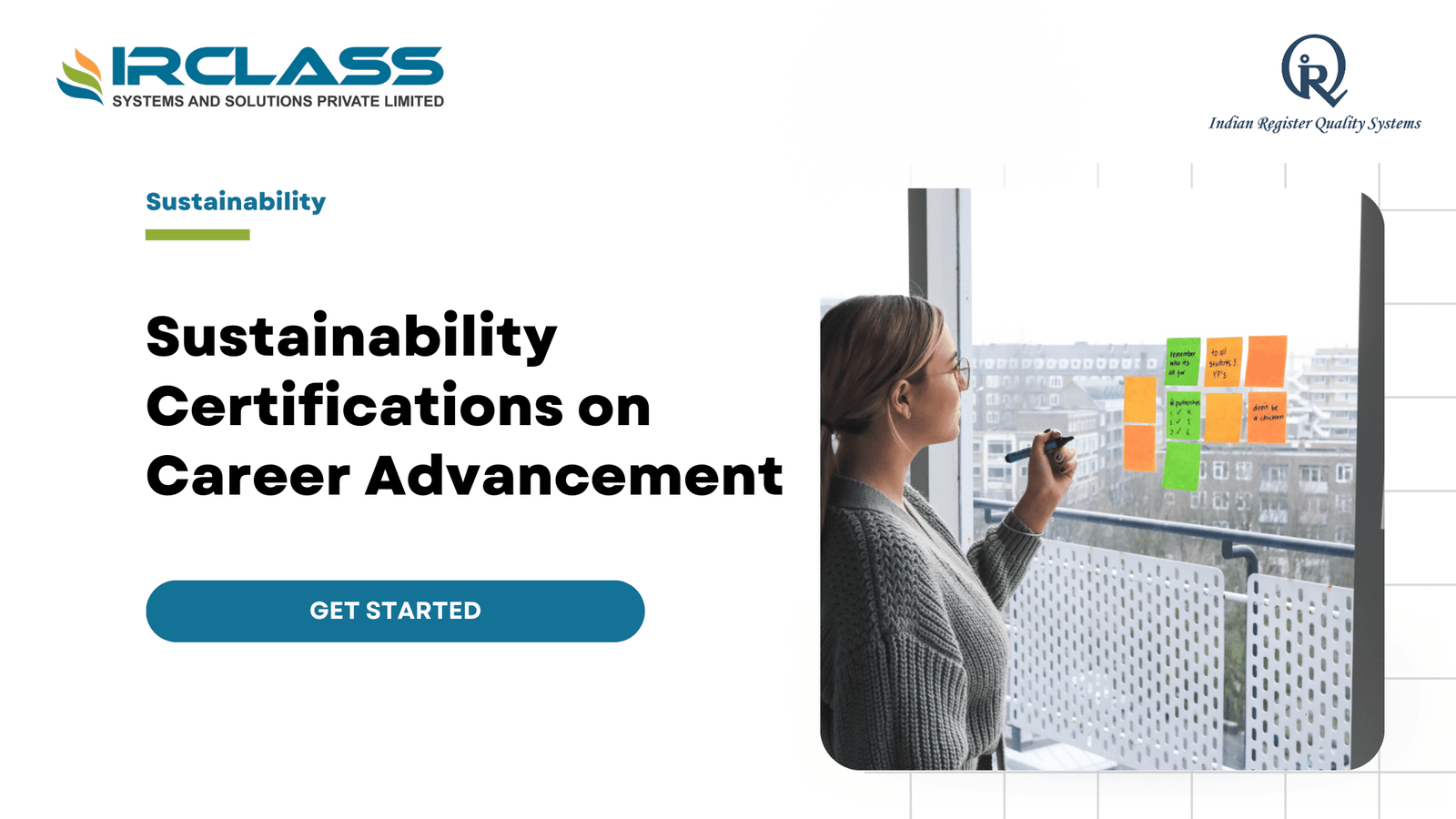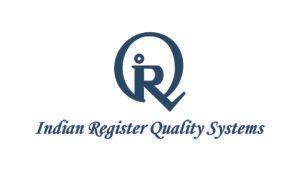Author: vishal
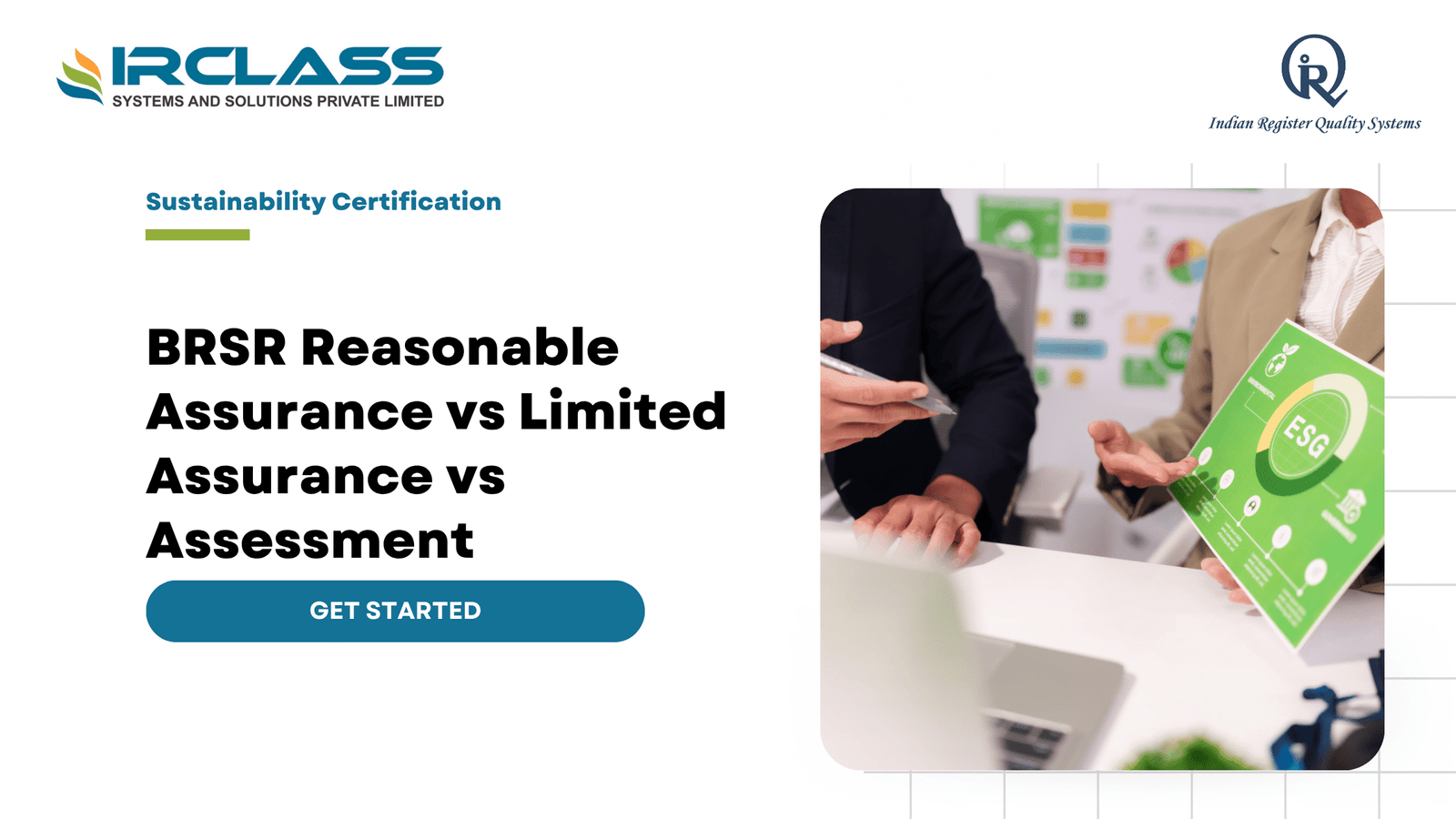
BRSR Reasonable Assurance vs Limited Assurance vs Assessment
Companies in India are now reporting ESG data not just for compliance but also for trust and clarity. The BRSR framework makes this process more formal through defined indicators along with a push for third-party assurance. For listed companies, the difference between an internal review and an external opinion is now part of regulatory expectations. Knowing how assessment works along with how limited and reasonable assurance compare is the first step to preparing your ESG report the right way. Why assurance matters in ESG reporting Assurance brings structure to how companies report non-financial data. It helps confirm that the data is correct along with consistent across time periods and reporting boundaries. The SEBI BRSR Core framework makes assurance mandatory for certain ESG indicators. This rule will apply to the top 1,000 companies in India by financial year 2026–27. That means your team needs to move from internal tracking to verified reports that others can rely on. What assessment means and what it covers ESG assessment is usually conducted at the initial stage of reporting. It assists in mapping the most important things as well as missing data. The company can do this on its own or through a consulting partner. Assessment assists in developing the report, but not the degree of review that is associated with assurance. It is useful in preparation and planning but is not considered as formal validation under BRSR. How limited assurance works Limited assurance is a third-party review that checks if the report contains major issues or clear mistakes. It relies on small samples along with interviews and does not go very deep. The final opinion is usually written as a negative statement. It says that no material misstatements were found but does not confirm full accuracy. Limited assurance is common in early-stage ESG reporting or when regulations do not ask for full verification. What reasonable assurance includes Reasonable assurance is a deeper and more structured review. The third party tests the company’s systems along with the data and the process behind it. They look at how the company collects information and whether it can be traced to a valid source. This level of assurance ends with a positive statement which confirms that the data is accurate based on the review. It is the only level accepted for the mandatory BRSR Core indicators under SEBI’s rule. SEBI’s assurance timeline SEBI has introduced a clear path for how companies will move into reasonable assurance. The indicators covered include emissions, energy, water, waste, safety, workforce and other core metrics that can be verified through data. What companies need to be ready Reasonable assurance cannot be done in a rush. Your company needs strong records along with consistent reporting systems. Every ESG metric should have a clear owner and a method that can be reviewed. You also need to know which KPIs are required and whether the data is available across your operations and value chain. Any gaps should be fixed before the review begins. Where GRI reporting supports assurance GRI is a voluntary reporting system but it offers a structured way to manage ESG data. It helps define what matters and builds a path to deeper reporting. Since SEBI’s BRSR Core is now mandatory, GRI can help support the process by offering detail, clarity and context. The GRI and BSE mapping document also shows which GRI indicators match BRSR disclosures. Using both together helps create a report that is easier to assure. How companies are using both GRI and BRSR Many companies now use GRI to build out the full report and meet global stakeholder needs. They then use the BRSR Core as the base for compliance. GRI adds materiality along with narrative and policy detail which helps support the assurance process. This approach reduces confusion and gives companies a way to meet local rules and global expectations without writing two separate reports. Key differences between the three levels Review Type Done By Depth of Review Accepted for BRSR Core Assessment Internal or advisory firm High-level scan of data and gaps No Limited Assurance Independent third party Surface-level testing with limited scope No Reasonable Assurance Independent third party Deep testing of data and controls Yes Steps to prepare for reasonable assurance • Check which BRSR Core KPIs need assurance and map them to your internal data • Assign owners across departments to manage data sources and tracking • Use mock audits to check whether data is traceable and policy support is clear • Apply GRI to add structure and consistency across topics and metrics • Work with your assurance partner early to avoid issues during final review Why this shift matters now Assurance is no longer optional for many companies in India. Investors along with regulators, want ESG data that can be trusted. Limited assurance may work for general reportin,g but will not meet the standard now required under BRSR Core. Companies that wait too long to prepare may face last-minute pressure or risk non-compliance. How Indian Register Quality Systems can support your team Indian Register Quality Systems works with companies that need support across all three levels. Whether you are building your first ESG report or preparing for reasonable assurance, our team helps you move step by step. With clear planning and careful delivery, we help you meet SEBI requirements without added confusion or wasted time. FAQs What is the difference between assessment and assurance in ESG reporting? Assessment helps you review ESG practices and identify gaps while assurance checks if your data is accurate and ready to meet external reporting rules. Does SEBI require limited assurance or reasonable assurance for BRSR Core? SEBI requires companies to obtain reasonable assurance for specific ESG indicators under BRSR Core and does not accept limited assurance for those metrics. Can a company use GRI reporting to support BRSR compliance? Yes, using GRI helps companies structure their ESG data and supports BRSR disclosures with clear topics along with globally recognised reporting standards. Who is required to follow BRSR Core
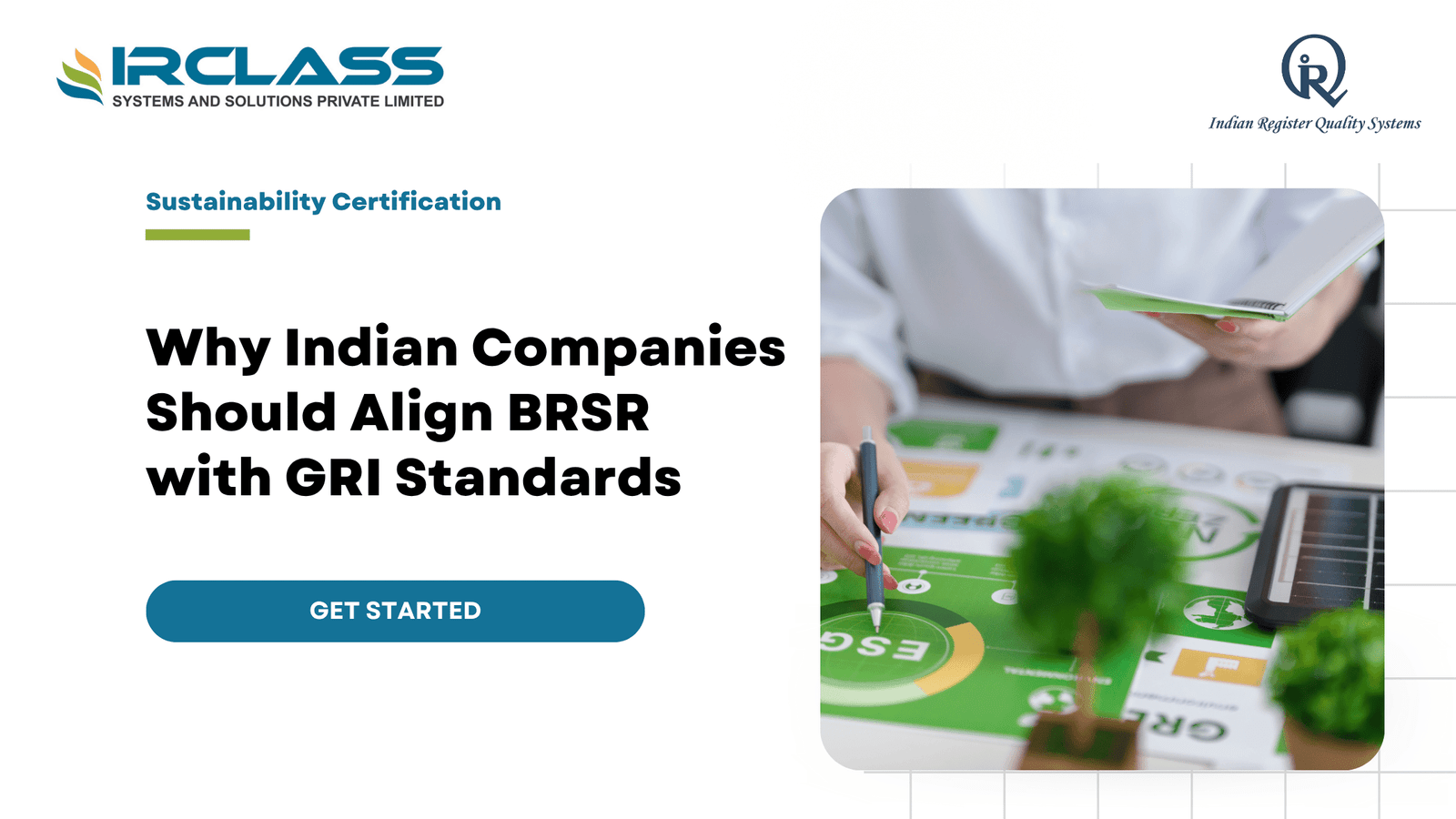
GRI Reporting and SEBI’s BRSR: Building Credible ESG Reports for Indian Companies
In India, more companies are paying attention to sustainability reporting due to the desire to demonstrate obvious evidence of the impact of their activity on people and the planet. It is no longer a formal requirement to report, as investors and regulators are requiring more transparency. The Global Reporting Initiative or GRI offers companies a chance to report their environmental, social, and governance data in a credible and organized format. Why GRI matters for Indian companies today GRI reporting assists companies in quantifying and report their ESG performance in a manner that is comprehensible by people. It provides organization to the data that would otherwise remain dispersed among departments. This is to produce one report that links the activities of an organization with their effects on society and the environment. This facilitates easier comparison of performance across time and sectors by the investors and customers. How SEBI’s BRSR changes the ESG reporting space The Securities and Exchange Board of India introduced the Business Responsibility and Sustainability Reporting framework, known as BRSR, to bring consistency to ESG reporting. This rule applies to the top one thousand listed companies by market capitalization. It requires companies to disclose ESG indicators that show how responsibly they manage environmental and social risks. While GRI is voluntary, BRSR is mandatory for these top companies. When used together, they form a system that covers both compliance and credibility. GRI and BRSR: how they connect in practice GRI and BRSR share similar goals but serve slightly different audiences. GRI gives a global view that supports comparison across countries along with sectors. BRSR focuses on India’s specific social and environmental priorities. The GRI Standards have been mapped against the BRSR indicators so that companies can prepare one report that satisfies both sets of requirements. This mapping was developed by GRI in partnership with the Bombay Stock Exchange to help Indian companies streamline their ESG work. Voluntary versus mandatory: what companies should understand GRI remains a voluntary framework that companies adopt to improve the quality of their ESG communication. The BRSR of SEBI, on the other hand, is compulsory to the leading listed companies in India. Those companies that integrate both strategies are able to fulfill the expectations of the national compliance and remain updated with the global investors. This balance assists them in reporting without having to repeat the same process under two different systems. Global versus local: how GRI and BRSR complement each other GRI supports global comparability because it follows internationally accepted standards. BRSR focuses on local social and governance needs that are specific to India. The key structure of GRI reporting GRI reporting follows a modular structure that includes Universal, Sector, and Topic Standards. Universal Standards form the foundation because they define the organization’s governance, values, and reporting process. Sector Standards address industry‑specific topics that vary from manufacturing to services. Topic Standards cover detailed ESG areas such as emissions, waste, and labor safety. This structure gives flexibility while keeping every report comparable and complete. Understanding SEBI’s BRSR Core requirements In 2023, SEBI published the BRSR Core to enhance the quality of ESG reporting. The BRSR Core has fewer key indicators that should be reported using verified data. These are greenhouse gas emissions, employee welfare, and value-chain disclosure. In the case of selected indicators, companies should seek reasonable assurance from an independent third party. By 2026-27, this assurance process will be mandatory for the leading companies. How companies can align GRI with BRSR Core The value of a materiality‑based approach GRI reporting is built around the idea of materiality, which means focusing on the issues that matter most. Companies start by identifying their actual and potential ESG impacts across their value chain. These are then ranked by significance and scope to decide which topics must be reported. The same logic supports BRSR because SEBI expects companies to share information that is relevant to their operations along with stakeholder interests. A materiality‑based report is easier to read and more useful for decision‑making. Why GRI makes BRSR reports stronger BRSR offers a well-organized list of indicators and does not necessarily leave room to elaborate. GRI bridges that gap by giving companies the opportunity to provide context and rationale to each disclosure. It provides room to outline strategy, policy and action plans in simple terms. This assists the stakeholders in not only knowing what a company has accomplished but also how it intends to enhance its performance. Combining GRI and BRSR will give a report that conveys both facts and intent. Benefits of GRI alignment for Indian companies The alignment with GRI will have a practical benefit to companies that already report under BRSR. It assists in enhancing internal data systems and encourages uniform data gathering within departments. It also establishes credibility among foreign investors and other global supply-chain partners who are aware of the GRI framework. Above all, it transforms ESG reporting into a long-term strategic instrument that contributes to growth and accountability. How GRI and BRSR reporting drive better ESG performance A feedback loop is established when both frameworks are used concurrently by companies. Information collected by BRSR assists in fulfilling local requirements, whereas GRI provides more insight into the performance patterns. This combination assists in the early identification of risks and demonstrates the areas of improvement. In the long run, it assists the management in establishing more robust sustainability objectives that are quantifiable and achievable. The strategy also equips businesses with the future changes in regulations as ESG reporting develops in markets. The path forward for ESG reporting in India With the increasing ESG demands, Indian companies will still be under pressure to report in a clear, credible, and comparable manner. GRI provides a platform that facilitates international presence. BRSR by SEBI makes all large companies accountable at home. The combination of the two frameworks offers a balanced approach that is suitable for both national regulations and global standards. Those who embrace both today will remain on the curve and be prepared to change in the
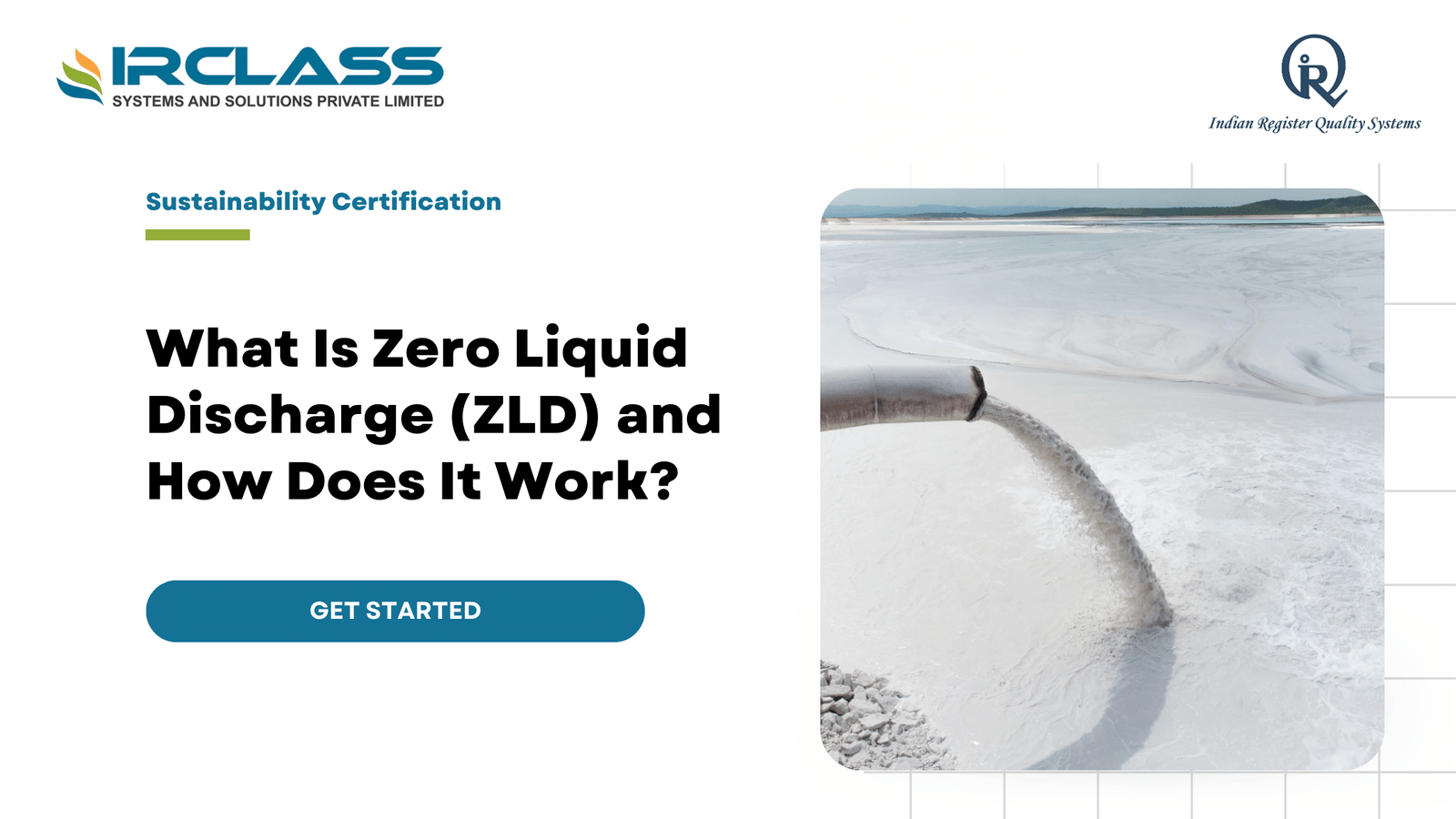
What Is Zero Liquid Discharge (ZLD) and How Does It Work?
What ZLD means Zero Liquid Discharge means your site does not release wastewater. You capture every drop and turn it into clean water or dry waste. That includes water from cleaning along with cooling and production. No part of it leaves the site as liquid. Why companies care Many sites use large volumes of water to run day-to-day operations. That includes manufacturing along with power generation and cleaning. Local rules now limit how much water you can discharge. Some sites are banned from discharging at all. ZLD helps you keep operating in those areas. Where this process starts You begin by collecting wastewater from across the site. That includes water used in cooling along with process steps and cleaning stations. It all moves into one system that can separate solids and prepare the water for reuse or final treatment. What happens first The water enters basic treatment. This removes solids using physical filters along with tanks and simple systems. Solids are sent to waste bins. Once solids are removed, the water moves into the next stage. That next stage depends on how clean the water needs to be. What happens next If the water is dirty but reusable, it goes through more treatment. That might include chemicals or filtration steps. If the water still cannot be reused, it goes to an evaporator. The evaporator removes all liquid and leaves behind dry waste. What happens to the recovered water Clean water is collected from the evaporator. This water is used again in the same facility. Some use it for cooling. Others use it for cleaning or boiler feed. It depends on what your site needs. Reusing the water reduces your need to buy more water from outside. What happens to the dry waste Dry waste is collected and removed from the site. Some sites send this waste to approved disposal. Others look for ways to reuse it or send it for recovery. Either way, no liquid is left in the final waste. Why this matters to regulators When you stop discharging liquid waste, you lower your pollution risk. That means fewer concerns from the local authorities and fewer complaints from nearby communities. ZLD gives them proof that you are handling water the right way. Why this matters to your team Teams can stop worrying about daily discharge limits or water-related shutdowns. ZLD helps you avoid surprises during inspections. It also gives your team more control over water planning. That includes supply risk along with water quality and process uptime. What kind of site needs this ZLD is useful in places where water is expensive or hard to find. It also makes sense if you face discharge limits or have no access to drains. Sites that handle chemicals along with salts and heavy waste often turn to ZLD first. What kind of water can be treated Most ZLD systems can treat water from cooling towers along with process lines and cleaning areas. That includes high TDS water and some hazardous streams. The harder the water, the more steps you will need. The system must match your process and water profile. What goes into planning You start by mapping how water moves through your site. You track how much is used along with where it goes and how dirty it gets. This helps you design a system that fits your needs. It also shows where you can cut waste before you treat it. What a typical ZLD system includes Most systems include filters to remove solids, tanks for balance, chemical treatment for tough water, and an evaporator to remove final liquid. Some use crystallizers to make solids easier to handle. The full setup depends on your site layout and process steps. What ZLD costs over time ZLD is a capital project. It needs space along with energy and trained teams. It adds cost up front but reduces risk over time. You save on water bills along with discharge fees and regulatory costs. In some cases, those savings cover the system within a few years. What your team needs to manage Once installed, the system runs daily. Teams must track flows along with water quality and energy use. You need records that show how much water is reused and how much waste is removed. If the system breaks, your team must act fast to avoid water buildup. What problems can come up If water flow changes or waste levels spike, the system may need adjustment. Dirty water can block filters or lower recovery. Staff must know how to respond and when to call for support. Maintenance is key to avoiding unplanned downtime. What to do before choosing ZLD Check your site layout. Confirm your water quality and process needs. Get a clear picture of how much space and energy is available. Review local rules and discharge limits. ZLD makes sense in many cases, but only if it fits your real-world constraints. What to track during operation Track water coming in and water going out. Track solid waste by weight. Keep records from every shift. Use simple logs or digital tools. This helps during inspections and supports your internal goals. Good records also help you find problems before they grow. How to train your team ZLD needs cross-team input. That includes production along with maintenance and water management. Each group must understand its role. Clear checklists help. Ongoing training is useful when staff rotate or when systems get upgraded. What success looks like Your site runs without sending water to drains. Clean water is reused across the process. Dry waste is handled with no spills or violations. Teams stay on top of daily checks. Records are in place. No one waits until the system fails to react. Who to work with Indian Register Quality Systems helps companies build and manage ZLD systems. They support planning along with audits and system checks. Learn more at irqs.co.in. FAQs 1. What is Zero Liquid Discharge? Zero Liquid Discharge means the site does not release any liquid waste.
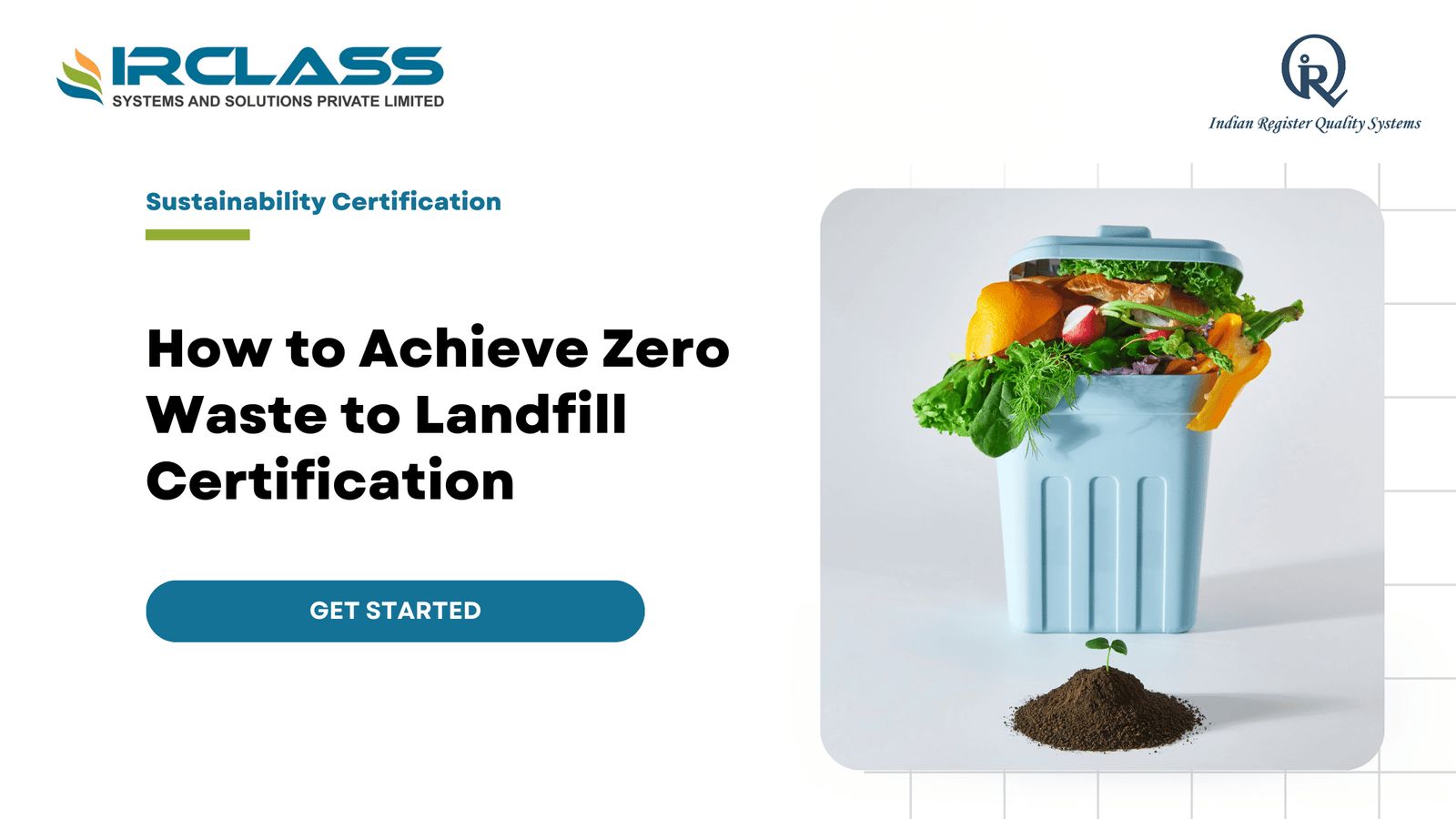
How to Achieve Zero Waste to Landfill Certification: Step-by-Step Guide
Zero Waste to Landfill means that your company sends little to no waste to landfill. Instead, the waste is reused, recycled or recovered. The goal is not just to manage waste but to remove it from landfill entirely. Many companies aim for this because it reduces cost along with environmental impact and builds stronger trust with customers. Why companies work toward this certification Most businesses create waste through production along with packaging and daily operations. A large part of this waste goes to landfill unless there is a better plan in place. Zero Waste to Landfill Certification helps your company prove that it has taken steps to divert waste. This kind of recognition helps support environmental goals and meet supply chain demands. Where the process starts The first step is to run a waste audit. This means checking where waste is coming from across your operations. You need to list the types of waste along with where they go and how much is produced. This includes regular waste along with hazardous and non-hazardous materials. The goal is to understand how waste flows through the business so you can make clear changes. How to prepare your waste data Once the audit is done you will need to organize your data by waste type along with destination and volume. You must separate waste that is recycled from waste that is incinerated or landfilled. Some waste may go to recovery processes such as composting or energy conversion. This data must be kept accurate and traceable. Certification bodies will review this data as part of the process. What counts toward Zero Waste to Landfill To meet the standard your business must divert at least 99 percent of its waste away from landfill. This includes reuse along with recycling and energy recovery. Waste that is landfilled must be under one percent. If you send waste to an incinerator without recovery then it does not count toward diversion. You must show proof for every category through vendor records or processing reports. Why waste segregation is essential Segregating waste makes it easier to track and manage. If waste is mixed together you lose the ability to sort it for recovery. Most companies set up separate bins along with clear labels to help staff sort waste correctly. Training is often needed to help teams follow the new system. This step improves the quality of recyclables and reduces the amount that ends up in landfill. How to engage with waste vendors You will need support from external waste vendors to meet your goal. That includes recyclers along with recovery service providers and composting facilities. Make sure your vendors provide valid documentation for all waste they handle. The records must show how much was received and where it was sent. If any vendor sends waste to landfill it may impact your status and delay your certification. How to handle hard-to-recycle materials Some materials do not have clear recycling options. These may include mixed plastics along with industrial sludges and certain types of packaging. You can look for recovery options such as energy-from-waste or explore alternatives to replace these materials in your process. Some companies partner with research groups or suppliers to reduce the use of these difficult materials over time. What records to maintain during the process You will need to collect detailed records for every type of waste and every waste movement. These records must match the totals from your audit. That includes transport receipts along with processing reports and diversion confirmations. The records must cover at least twelve months unless the certifying body allows a shorter review window. Keep everything well organized and ready for inspection. How to train your staff The shift to Zero Waste to Landfill needs support from your entire team. Staff must understand how to sort waste correctly along with how to reduce waste at the source. Clear instructions should be posted in all work areas. Some companies run short training sessions or assign waste champions in each department. This helps reduce errors and improve reporting quality. How certification bodies review your data A certification agency will visit your facility and will review your audit findings and your waste tracking records. They are able to inspect bins and collection points and communicate with employees. This is to make sure that the data you reported is in accordance with real results. Where there may be gaps in the records or any documentation that you may be called upon to produce, then before certification is granted you may be called upon to make corrections. How to keep improving after certification Achieving Zero Waste to Landfill is a good goal but it does not imply that the job is done. Most companies seek how to go a notch higher by minimizing the overall waste or minimizing the cost associated with recovery. This may involve seeking superior packaging or re-using by-products of one process in another region. Continuous enhancement keeps the teams active and contributes to long-term value. Why internal ownership matters A program like this needs ownership across all levels of the business. Waste management is not only an issue for facilities teams. Product designers along with suppliers and operations leads all play a role. When each team takes responsibility for its part of the waste stream the overall result is stronger and more stable. What to expect during re-certification Every year your waste records will be reviewed again. This process is shorter than the first time but still requires full documentation. If you increase production or change suppliers your diversion rate may be affected. You must show that changes were managed and that your diversion rate is still above the required level. Missing documentation or weak practices can put the certification at risk. What to do if you fall short If your diversion rate drops below the required threshold you may be asked to submit a plan to correct the issue. Some certifiers may pause your certification until the problem is resolved. Most problems are
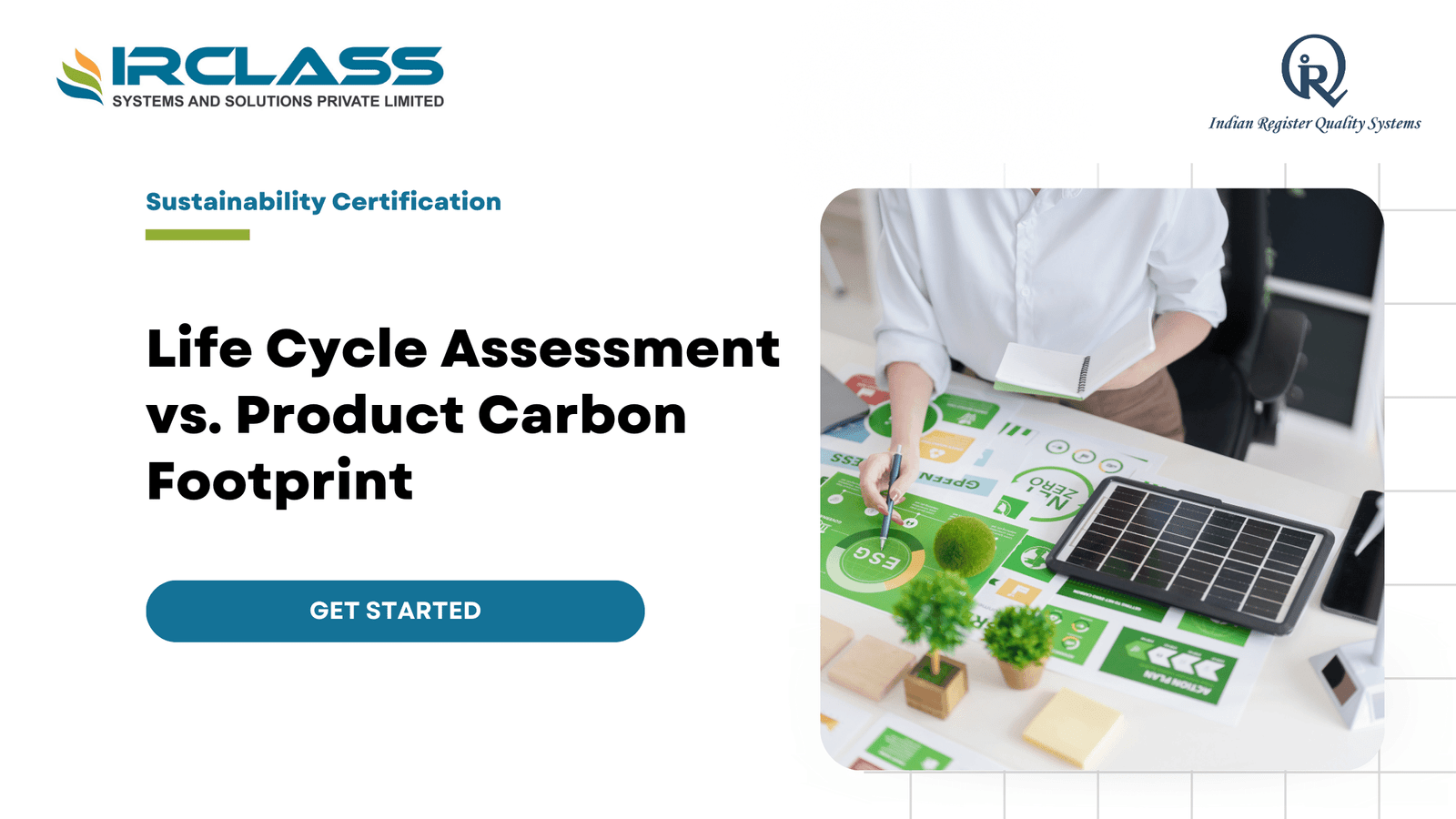
Life Cycle Assessment vs Product Carbon Footprint: What’s the Difference?
Many companies want to measure their environmental impact but do not always know which tool gives them the right answer. Life Cycle Assessment and Product Carbon Footprint are two options that help teams track impact across the full life of a product. These tools look similar but they do different things. What Life Cycle Assessment covers Life Cycle Assessment tracks how a product affects the environment from start to finish. It begins with raw material extraction and ends with disposal or recycling. The method covers every stage in between. That includes manufacturing along with transportation and product use. The goal is to give a full view of total environmental impact. This includes energy use along with water use and waste generation. Companies use Life Cycle Assessment to find ways to reduce overall harm in areas that go beyond carbon emissions. What Product Carbon Footprint focuses on Product Carbon Footprint only looks at greenhouse gas emissions. It measures how much carbon dioxide along with other gases are released across the life of a product. This includes emissions during production along with transport and use. It also includes the emissions caused when a product is thrown away or recycled. Unlike Life Cycle Assessment it does not track water use or other impacts. Product Carbon Footprint helps teams report carbon emissions and find ways to reduce them. Where the difference begins Life Cycle Assessment is a wide lens. Product Carbon Footprint is a zoomed-in view. One looks at all environmental effects. The other looks only at climate effects. That means they serve different goals. If you want to improve the product design across many areas then Life Cycle Assessment will give you the data you need. If you only want to meet a carbon target or get a label then Product Carbon Footprint is the better choice. How standards make these tools work Both methods follow global standards. Life Cycle Assessment is based on ISO 14040 along with ISO 14044. These standards help define how environmental data is collected and reviewed. Product Carbon Footprint follows ISO 14067. That standard is built to measure greenhouse gas emissions across product life cycles. Using the correct standard gives structure to your reporting and makes results easier to understand. Standards also help other teams review your work without needing extra explanation. Why data is the first step Both tools depend on strong data. You need to gather facts about materials along with transport and use patterns. You also need to know how the product is handled at the end of its life. That could mean disposal or recycling or something else. This information often comes from suppliers along with internal records. The more accurate the data the more useful the results. If the data is not complete then the results will not support the team in making better decisions. How Life Cycle Assessment supports product planning Product teams use Life Cycle Assessment to see where environmental impact is highest. That could be in the material choices or the production method. Sometimes a change in packaging can cut waste or reduce energy use. The goal is to help teams act before the product goes to market. This method supports design and sourcing decisions by showing which parts of the product do the most harm. It can also help in comparing product options before making large purchases. Where Product Carbon Footprint helps the most Product Carbon Footprint is useful for teams working on carbon goals. That might include internal targets or external disclosures. It can also support product claims like low-carbon or carbon-neutral. When a business wants to track only emissions this method gives a clear and focused view. Teams can see which stage of the product life causes the most emissions. That makes it easier to focus reduction efforts where they will matter most. Why both methods can work together Some companies use both tools. You can begin with a Product Carbon Footprint to meet an urgent carbon reporting need. Then you can expand into a full Life Cycle Assessment to improve design or sourcing for the next version of the product. The two methods do not compete. They solve different problems. They can also support each other when used in sequence. Product Carbon Footprint tells you where carbon is high. Life Cycle Assessment tells you how that carbon fits into the full environmental impact. When to start the process The best time to start an environmental assessment is early. That could be during product design or supply chain planning. Waiting until the product is already on the market limits your ability to make changes. These tools work best when they are part of normal product development. When they are built into the process teams can act on the results instead of just filing them away. The earlier the work begins the more value it brings. What teams need to stay on track Environmental assessment is not just a task for one team. It needs input from product teams along with procurement and operations. The data sits across many systems. Without clear roles and ownership the work can slow down or lose direction. Teams need to know why the data matters and how it supports business goals. When they understand the purpose they are more likely to provide what is needed on time and with the right level of detail. Why clarity in reporting matters The output from both tools should be easy to read and apply. A product manager should be able to look at the results and know what to fix. A supplier should be able to understand what kind of data is expected from them. Clear reporting builds trust across departments and keeps projects on track. If the report is too complex or technical it may not be used at all. The goal is to support action not just analysis. How to decide which tool fits your goal Choosing between Life Cycle Assessment and Product Carbon Footprint depends on what problem you are trying
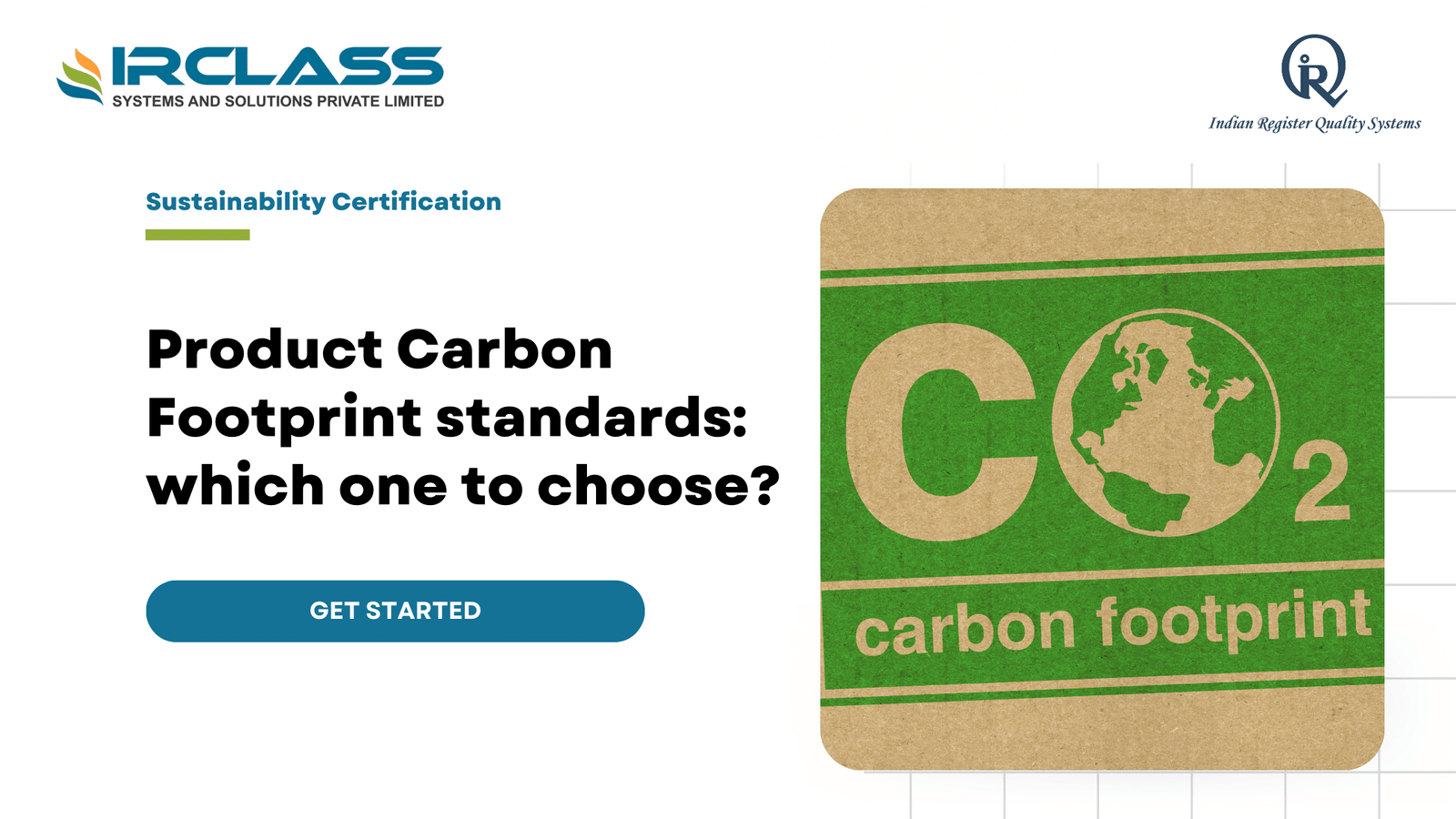
PAS 2050 vs ISO 14067: Which Carbon Footprint Standard Should You Choose?
Carbon footprint standards assist organizations to quantify the climatic impact of their products. However, it is confusing to select the right standard. The two most well-known are PAS 2050 and ISO 14067. Both are applied to measure greenhouse gas (GHG) emissions of products and services. However, they pursue different approaches and have different objectives. When you are attempting to develop a credible carbon reduction plan or substantiate climate-related claims, the standard you select is important. It influences the way you gather data, compute emissions, and report findings. It also influences the acceptability of your numbers by regulators, buyers and auditors. What Is PAS 2050? PAS 2050 is a Publicly Available Specification developed by the British Standards Institution. It was first published in 2008. The goal was to provide a consistent way to measure the life cycle GHG emissions of goods and services. PAS 2050 focuses heavily on product life cycles. It looks at all the stages from raw materials to disposal. That means it’s useful for companies in manufacturing, agriculture, and retail. If you need to assess the carbon footprint of a physical product, PAS 2050 gives you a structured approach. It’s also commonly used in supply chain projects. When a company wants to reduce emissions in its value chain, PAS 2050 helps identify where those emissions come from. What Is ISO 14067? ISO 14067 is an international standard that came later. It was published by the International Organization for Standardization in 2018. It builds on earlier standards like ISO 14040 and ISO 14044, which cover life cycle assessments (LCAs). ISO 14067 focuses specifically on the carbon footprint of products, but it’s designed to be globally consistent. It includes clear guidelines for how to quantify and communicate GHG emissions. It also provides rules on how to handle data gaps, uncertainty, and system boundaries. This standard is more specific in certain aspects, particularly documentation and third-party verification. It is frequently applied when companies must comply with global supply chain demands or when carbon claims will be third party audited. Key Differences Between PAS 2050 and ISO 14067 The two standards have a lot in common. Both follow a life cycle approach. Both include upstream and downstream emissions. Both allow cradle-to-gate or cradle-to-grave assessments. But they differ in scope, depth, and acceptance. Which One Should You Choose? The decision is based on your objective. PAS 2050 is sufficient when you are interested in product-level carbon footprinting of local supply chains or internal decision-making. It’s simpler to implement and works well for organizations just starting with carbon footprint analysis. But if you’re planning to disclose your carbon footprint in international markets or through ESG reports, ISO 14067 is the better choice. It gives you stronger documentation and global recognition. It’s also easier to integrate with other ISO systems you may already be using. If you’re preparing for third-party assurance or carbon labeling, ISO 14067 is often preferred by certifiers. That’s because it has clear documentation rules and aligns with other ISO verification methods. Industry Use Cases for Each Standard Various industries have various standards depending on the operations. PAS 2050 is common in agriculture and food. It is straightforward, product-oriented, and acceptable to buyers in food supply chains. In building, ISO 14067 is applied to environmental product declarations (EPDs). In automotive and electronics, where international trade is an issue, ISO 14067 is more prevalent. It assists firms to have consistency among countries and suppliers. In consumer goods, both standards are applied depending on whether the company is reporting locally or globally. If you operate in a sector with high ESG standards, such as finance or infrastructure, ISO 14067 provides greater alignment with sustainability reporting and investor reporting. How the Two Standards Handle Emissions Data Both standards require accurate GHG data, but the way they manage that data is different. PAS 2050 allows for more assumptions. That’s helpful when data is hard to get, but it also means the results may be less precise. ISO 14067 demands better data quality. It also requires companies to state how they dealt with uncertainty. This is useful when the carbon footprint will be audited or published. In practical terms, ISO 14067 needs more time, effort, and technical resources. But it delivers a more robust and transparent footprint calculation. Carbon Reduction and Communication Both PAS 2050 and ISO 14067 help companies to reduce emissions. ISO 14067 offers more open directions on reporting outcomes. In order to communicate publicly, e.g. that a product has a 30 percent lower carbon footprint, you will have to comply with more rigorous communication requirements. PAS 2050 allows claims too, but they may not always meet international expectations. If you plan to use product labeling, marketing materials, or ESG disclosures, ISO 14067 is safer. It supports consistent and verified claims that reduce greenwashing risk. Which Standard Supports ESG Reporting Better? ISO 14067 integrates more easily into ESG reporting frameworks. It supports the kind of traceable, third-party verified data that auditors and investors expect. If your goal is to align with TCFD, CDP, or CSRD disclosures, ISO 14067 fits better. PAS 2050 is useful for internal assessments and supplier engagement. But it may require extra effort to convert the results into ESG-ready formats. ISO 14067 offers a cleaner path from measurement to disclosure. Cost and Complexity PAS 2050 is quicker and less expensive to use. It is appropriate to SMEs or companies that want to take a first step in carbon accounting. ISO 14067 is more time-consuming and labor-intensive, but it is worth the investment in the long-term perspective in case you want to be compliant, report, and certify. The price variance usually varies with the scope of the project, internal capabilities and whether you are doing in-house analysis or hiring a consultant. Either way, the most costly option is the one that fails to satisfy your reporting or verification objectives. Conclusion Both PAS 2050 and ISO 14067 assist organizations to measure and manage their carbon footprint. The correct option is based on your
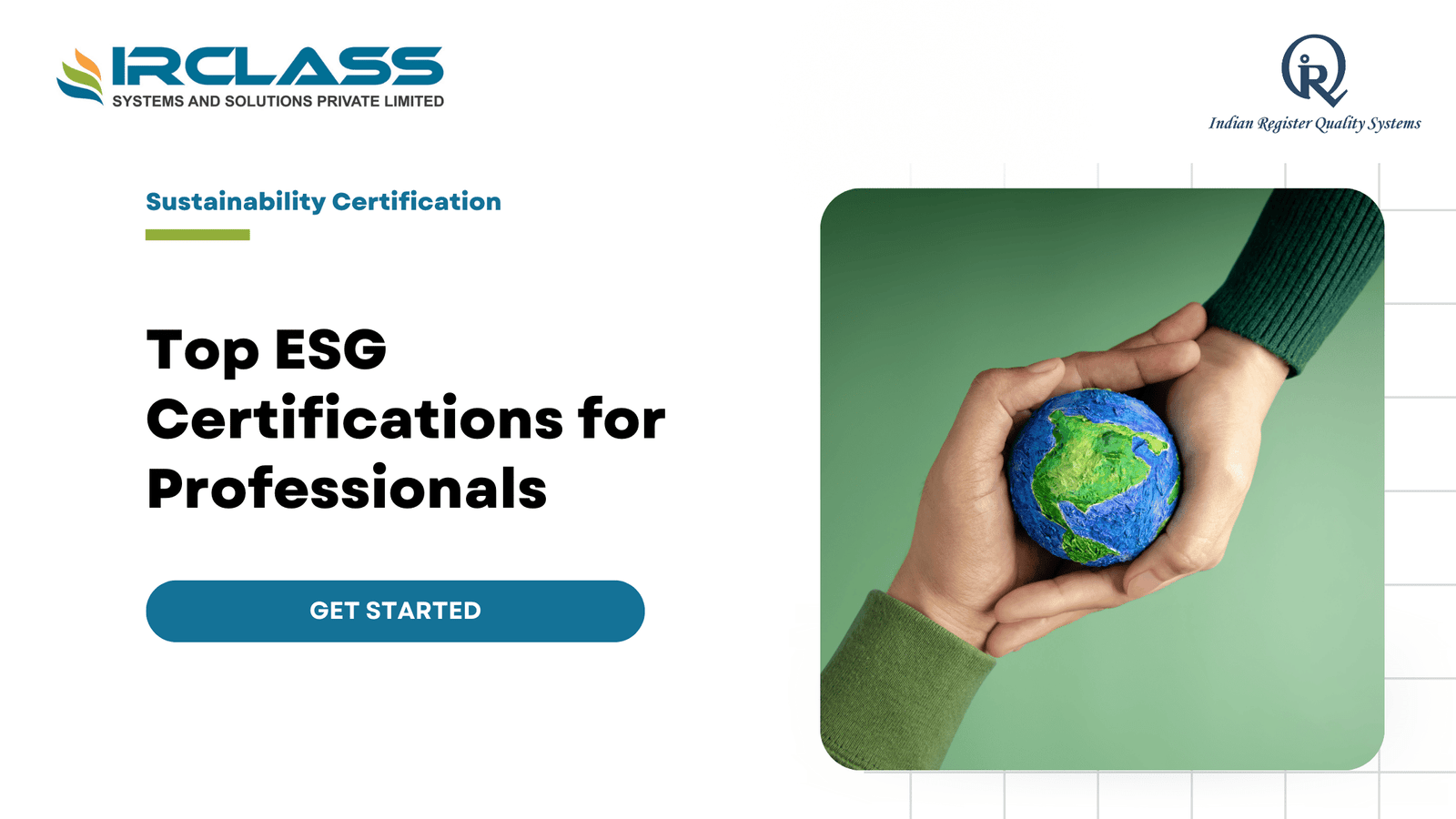
Top ESG Certifications for Finance, Sustainability, and Compliance Professionals
Finance, sustainability, and compliance are now deeply connected through ESG. Whether you’re managing risk, allocating capital, or aligning with regulations, ESG is part of your role. But ESG frameworks are complex. Investors want accurate disclosures. Regulators expect transparency. Boards demand strategy. Professionals need the right training to keep up, and that’s where ESG certifications matter. A good ESG certification teaches you how to interpret data, follow global standards, and apply ESG thinking to your daily work. Whether you’re building an investment model, conducting a sustainability audit, or writing a compliance report, the right certification helps you do it with accuracy and confidence. Why ESG Matters in Finance, Sustainability, and Compliance Each of these fields touches ESG in a different way. In finance, ESG influences credit ratings, valuations, and long-term investment decisions. In sustainability, it drives climate strategy, net-zero targets, and social impact. It is not about compliance; it is about aligning with international standards such as TCFD, GRI, and CSRD and avoiding greenwashing. Without proper ESG knowledge, even the best professionals make mistakes. They misread disclosures. They apply the wrong metrics. Or worse, they leave out key risks. ESG certifications reduce that gap by training people in standards, risk assessment, and data reporting. How ESG Certifications Support Different Roles In finance, certifications help you integrate ESG into models and portfolios. You learn how to assess climate risks, interpret sustainability disclosures, and apply ESG metrics in credit decisions. This is now critical for investors, lenders, and risk managers. In sustainability, certifications are more in-depth in terms of carbon accounting, supply chain risks, and stakeholder engagement. You get to know how to develop sustainability strategies that are compliant with regulations and investor demands. In compliance, the focus is on frameworks and assurance. You learn how to map ESG risks, assess materiality, and ensure your company’s reports meet legal and audit standards. Core ESG Skills Professionals Must Learn A certification must teach practical, usable skills. Not just theory. ESG professionals now deal with: These are not optional skills anymore. Without them, professionals can’t meet the expectations of regulators, auditors, and investors. Choosing a Certification That Aligns With Your Role Certifications vary in depth and focus. Some are entry-level, built for people just entering the ESG field. Others are advanced and designed for senior professionals working in risk, finance, audit, or strategy. Choose a certification that fits your function. If you’re in finance, you need a certification that focuses on ESG integration in investment and credit. If you’re in compliance, you need something focused on disclosures and regulatory frameworks. If you’re in sustainability, you need one that goes deep into net-zero targets and lifecycle analysis. A one-size-fits-all ESG certification rarely works. ESG roles are too diverse. Pick one that supports your specific career path. How ESG Regulations Are Changing the Job Landscape Across the world, ESG regulations are increasing. The EU has introduced CSRD, which mandates detailed ESG disclosures. India has made BRSR reporting compulsory for top-listed firms. The U.S. SEC has proposed climate risk disclosures. Other regions are updating their guidelines every year. This has created demand for ESG-literate professionals. Companies need people who know how to read and write ESG reports, validate ESG data, and align disclosures with global frameworks. ESG certifications are now seen as essential by HR and compliance departments. In job descriptions, “ESG certified” is no longer a bonus. It’s often a requirement. What Makes a Certification Credible There are many ESG programs in the market. But not all of them are recognized. A credible certification should follow global standards. It should offer in-depth content and updated case studies. It should be backed by industry recognition. The trainer profile also matters. You want instructors who have worked in ESG implementation, not just theory. You also want real examples of how companies handled ESG audits, how regulators reviewed sustainability disclosures, and what mistakes to avoid. Look for certifications that include: Format and Delivery Options That Work for Busy Professionals Most ESG professionals are already working full-time. That’s why the format of the certification matters. Some programs are self-paced online courses. Others offer live sessions or workshops. Some include case studies, quizzes, and simulations. If you’re in a technical role like internal audit or compliance, you may benefit from instructor-led sessions. If you’re in strategy or consulting, a project-based certification may be more useful. Choose a format that matches how you learn and how you work. The Link Between ESG Certification and Career Growth Professionals with ESG certifications are getting promoted faster. They’re also being hired for specialized roles like: These roles didn’t exist a few years ago. Now they’re in demand across sectors like banking, manufacturing, technology, and infrastructure. ESG certifications give professionals the edge because they show readiness. Not just interest, but capability. Hiring managers look for proof of knowledge. Certifications provide that. Future-Proofing Your Skills With ESG Training ESG is not a trend. It’s a shift in how businesses operate and report. Financial disclosures now come with ESG metrics. Strategic plans now include climate and social risk. Boards are asking questions they never asked before. This shift will continue. New laws will come. Reporting expectations will grow. Investors will want deeper insights. ESG-certified professionals will be the ones ready to answer. Getting certified now prepares you for what’s coming. Conclusion Professionals in finance, sustainability, and compliance all play a role in ESG success. However, to meet the rising expectations of regulators, boards, and investors, they need proper training. ESG certifications provide that training, along with credibility and career mobility. IRQS offers globally aligned ESG certification programs that are designed for real-world application across sectors, job roles, and reporting requirements. If you’re looking to build expertise that lasts, start with a certification that fits your future. FAQs 1. To whom is an ESG certification applicable? It should be considered by anyone working in the fields of finance, sustainability, compliance, internal audit, or strategy. The SG certifications can guide you in knowing the frameworks, evaluating risks, and aligning your
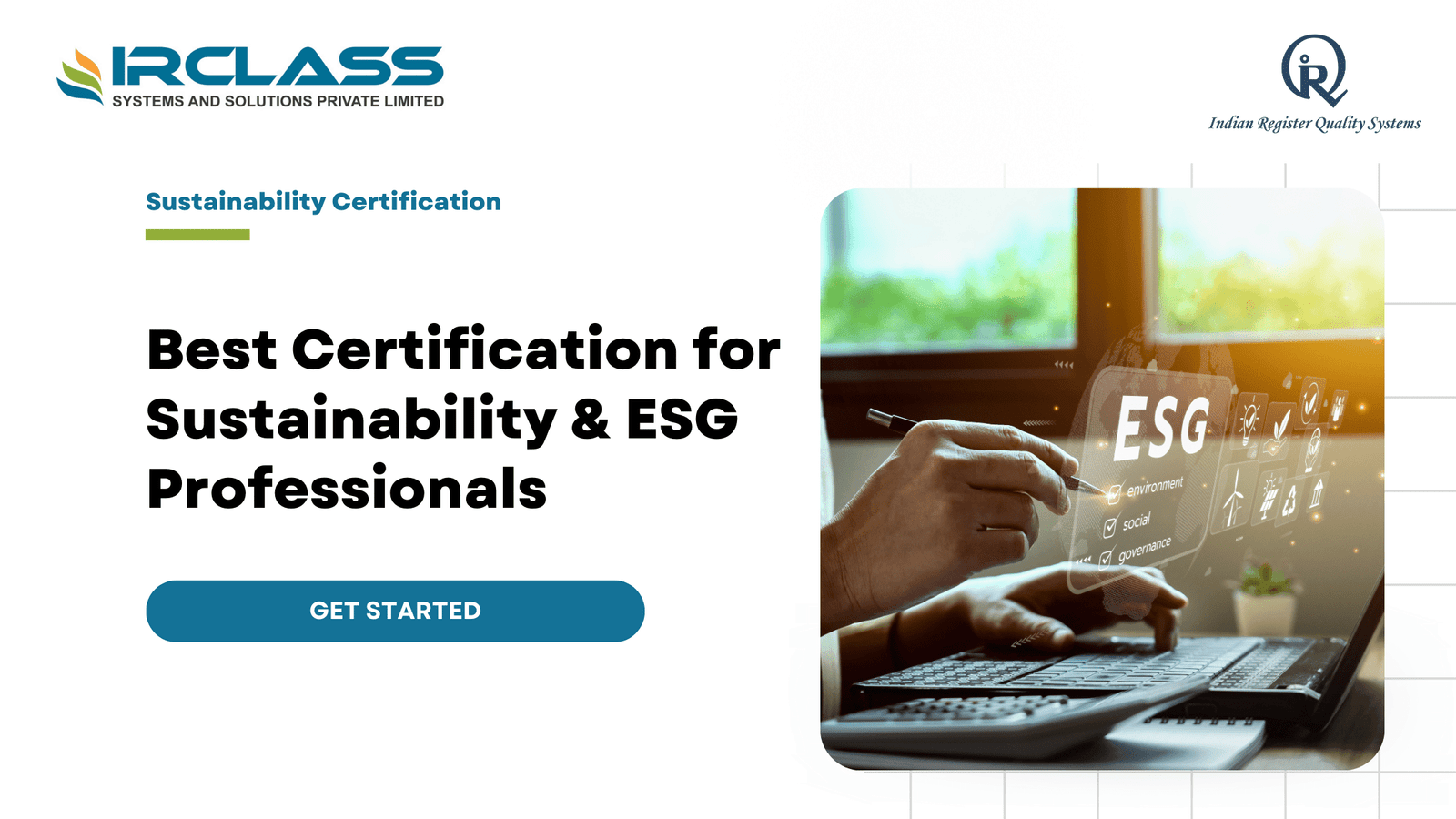
What’s the Best Certification for Sustainability & ESG Professionals
Sustainability and ESG are no longer optional. Shareholders, regulators, and consumers want companies to report on their effects on the environment, society, and governance. To meet these demands, businesses need experts who are conversant with ESG frameworks, reporting standards, and compliance. Certifications render these professionals relevant and credible. Sustainability and ESG have many certifications. Some are strategy-based, some are reporting-based, and others are audit-based or risk management-based. The decision to follow one or the other is based on your position, sector, and goals. The relevant certification will unlock the gateway to employment in ESG consulting, compliance, climate risk, and sustainability reporting. Why ESG and Sustainability Certifications Matter Companies need certified professionals because ESG reporting is complex. It involves understanding climate disclosures, sustainability risks, social impact, and governance frameworks. These frameworks differ by region and regulation. Certifications provide structure and help you show that you can handle this complexity. Certifications also build trust. When a company hires someone with a recognized credential, they know this person meets global standards. Whether it’s developing a net-zero strategy or conducting ESG audits, certifications prove your skills. Key Areas Covered by Most ESG Certifications While each certification has its own focus, most of them include: Some programs go deeper into one area. If you want to specialize in climate risk or ESG strategy, you need to pick a certification that aligns with that focus. What to Look for in a Good ESG Certification Not all certifications are the same. Some are better suited for entry-level professionals, while others are made for senior leaders. The delivery format, global recognition, and technical depth all matter. If you’re just starting out, look for a foundational course that explains the basics of ESG. If you’re already working in compliance or risk, you need something more technical, with case studies and standards training. If you’re in internal audit, choose a course with ESG assurance modules. You also want a program that updates content regularly. ESG is evolving. What was relevant last year may not meet today’s disclosure requirements. Make sure the certification includes the latest frameworks. Certifications That ESG Professionals Consider There are certifications focused on corporate sustainability, and others that go deeper into ESG investing, disclosure, and assurance. Some are global; some are region-specific. Some are accredited; others are not. Professionals working in listed companies or firms subject to sustainability reporting regulations usually prefer certifications that include frameworks like TCFD, GRI, and the EU CSRD. ISO-based certifications are a better fit for assurance and internal audit roles. These include training in risk-based approaches, sustainability audits, and data validation. Certifications linked to ISO standards are also widely accepted. They follow a globally recognized structure and often include practical audit training. How These Certifications Are Structured Most ESG certifications follow a modular structure. You start with basic concepts like sustainability, governance, and risk. Then you move into reporting frameworks. Finally, you may go through case studies or simulations. Some courses are online and self-paced. Others are classroom-based with live instruction. If you’re working full-time, online options with flexible schedules help. But if you need networking or peer learning, classroom training works better. Some programs include exams. Others require a project or a case study analysis. Choose based on how you prefer to learn and prove your skills. What Companies Expect from ESG-Certified Professionals Today, companies don’t just want general sustainability awareness. They want you to know specific frameworks. They want people who can read ESG data, build a report, and review it for errors. In an internal audit, they want people who can validate disclosures. In compliance, they want people who can map ESG risks to regulatory guidelines. Some roles demand sector-specific ESG knowledge. For example, energy companies want professionals trained in Scope 3 emissions reporting. Financial institutions want people who understand climate risk in investment portfolios. A good ESG certification prepares you for these specific demands. The Global Shift Toward Mandatory ESG Reporting Many countries now require ESG disclosures. The EU has already enforced the Corporate Sustainability Reporting Directive (CSRD). India has mandated Business Responsibility and Sustainability Reporting (BRSR) for top-listed companies. The U.S. is moving toward climate-related disclosures. Other countries are catching up fast. This means that additional companies must find ways to identify and disclose ESG threats. Certified professionals are in demand because they bring clarity into the reporting process. They know what to disclose and how to present it to the regulators and investors. How to Choose the Right Certification for You Selecting the proper certification is a matter of your objectives. To work in strategy, choose a course that teaches ESG leadership. If you want to audit ESG reports, consider an assurance-oriented program. If you are in operations, seek training that connects ESG to business operations. Ask yourself: Don’t just look at the brand name. Look at the syllabus. Look at the trainer profiles. See who recognizes the certification. Talk to people who’ve taken it. How ESG Certifications Help You Stay Ahead The ESG field is still new, and it’s growing fast. Companies are building teams for ESG strategy, compliance, risk, and audit. They want people with proof of skills. ESG certifications help you stand out in job applications. They also help you make better decisions if you’re already in a leadership role. Certifications show you’re serious about the field. They show you understand sustainability beyond buzzwords. They give you frameworks, tools, and language to work with legal teams, auditors, and investors. They also help you build confidence. When you’re asked to lead a sustainability project or respond to a regulatory inquiry, you know what to do. You don’t guess. Conclusion The most useful certification is the one that can help you address the actual ESG issues. You may be involved in climate disclosures, ESG audits, or sustainable procurement, and you need training that is practical and up to date. The certifications provided by IRQS are internationally accepted, ISO-aligned, and practical in real-life ESG application. When you are serious about a career in sustainability, then
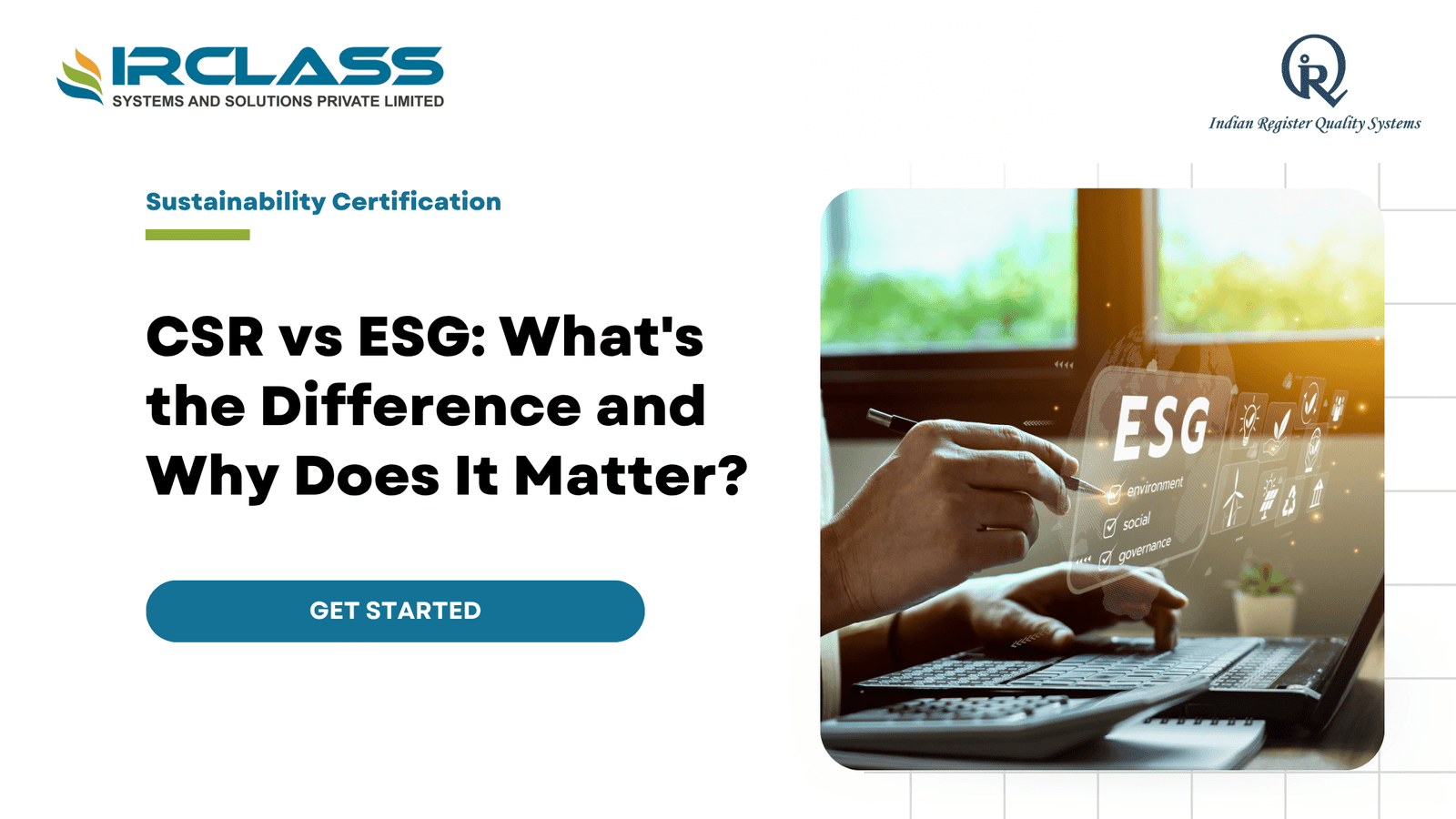
CSR Reporting vs ESG Reporting: What’s the Difference and Why It Matters
Firms desire to demonstrate that they are responsible. They desire to appear good to the customers, investors and employees. Two of the ways they attempt to do that are CSR and ESG. Yet they are not identical. These words are usually used interchangeably, yet they are not synonymous. The distinction is important to businesses, investors, and stakeholders. What is CSR Reporting CSR is the abbreviation of Corporate Social Responsibility. CSR reporting refers to the situation where a company reports on what it is doing to become a good corporate citizen. This normally involves social, environmental and ethical projects. It is all about good doing. CSR includes such things as: CSR reports are qualitative in nature. They explain activities and initiatives. The idea is to gain trust and demonstrate that the company is not only interested in profits. It is generally directed to the general population, workers, and occasionally regulators. What is ESG Reporting ESG stands for Environmental, Social, and Governance. ESG reporting is about data. It tracks how a company performs in these three areas using measurable indicators. The goal is to provide investors with information to assess risk and long-term value. ESG reports include: This is not just about values. It is about performance. ESG is designed to help financial stakeholders understand how well a company is managing non-financial risks. The Main Differences 1. Scope and Focus CSR is broad and value-based. It shows a company’s commitment to social good. ESG is focused and data-driven. It shows a company’s performance in key areas that affect long-term value. CSR might include starting a community recycling program. ESG would report how much waste was reduced and how that compares to industry benchmarks. 2. Purpose and Audience CSR speaks to the public. It builds brand image and trust. ESG speaks to investors. It helps them decide where to put their money. CSR is good for PR. ESG is good for business strategy and risk management. 3. Measurability and Standards CSR reporting is often anecdotal. It tells stories. ESG reporting uses hard data. It follows frameworks like GRI, SASB, and TCFD. These allow investors to compare companies side by side. CSR might say a company promotes work-life balance. ESG would show employee turnover, retention rates, and engagement metrics. 4. What Drives It CSR is driven by internal values. It is about doing what feels right. ESG is driven by external pressure. Investors, regulators, and markets demand accountability. CSR started as a moral decision. ESG is now a financial necessity. Why the Difference Matters It matters because mixing them up leads to confusion. Companies need to understand which one to focus on depending on the goal. For Businesses: CSR helps build culture and employee loyalty. ESG brings in investors and prepares the company for future regulations. Both matter, but they serve different purposes. For Investors: Investors want data. ESG helps them assess risk, sustainability, and long-term financial health. CSR won’t give them what they need to make decisions. For Stakeholders: Customers and communities want to know that companies care. CSR helps tell that story. ESG shows that it’s not just talk, but measurable action. CSR Is the Philosophy. ESG Is the Proof. CSR is a company saying, “We care.” ESG is a company showing, “Here’s how we’re doing.” One is about intention. The other is about accountability. You can have CSR without ESG, but it’s just storytelling. You can’t have strong ESG without the foundation of CSR, because you need values to guide what you measure. What Companies Need to Do Now The Role of Regulation in Pushing ESG Forward Governments and regulators are now stepping in. ESG is no longer just a nice-to-have. In many industries, it’s becoming a requirement. Global bodies like the European Union have introduced regulations such as the Corporate Sustainability Reporting Directive (CSRD). India has introduced the Business Responsibility and Sustainability Reporting (BRSR) framework. These are pushing companies to disclose specific environmental and social metrics. This is a major shift from the voluntary nature of traditional CSR. Regulators now want measurable outcomes. Companies that fail to report ESG data may face fines, lose investor trust, or struggle to access capital. Reporting is also being tied to tax benefits and public procurement eligibility. This means companies can’t just write feel-good stories anymore. They need real numbers. They need data they can stand behind. ESG helps ensure that the business is not only doing good but also protecting itself against future legal, environmental, and reputational risks. Companies that get ahead of these requirements will have a competitive advantage. Those that don’t will be left behind. Regulation has moved ESG from marketing to mandatory, and businesses need to act now. Why ESG Brings More Value Than CSR Alone CSR shows the world that a company wants to do the right thing. That matters. But ESG adds a layer that CSR cannot deliver—proof. Investors, banks, insurers, and regulators want evidence. They want to know if a business is future-proof. ESG gives them that. It’s not about reporting for the sake of it. ESG data can uncover risks before they become problems. For example, high energy use today may become a financial liability tomorrow if carbon taxes increase. A lack of diversity today could turn into a talent drain and reputational risk later. Good ESG practices improve decision-making, reduce costs, and increase access to funding. CSR helps a company look good. ESG helps a company stay strong. It connects non-financial factors to financial outcomes. That’s why ESG is now part of many investment strategies, credit scoring models, and supply chain audits. This is where companies need to shift their mindset. CSR is not enough anymore. It’s a part of the picture, not the full story. ESG brings structure, benchmarks, and accountability. In today’s economy, that brings more long-term value than branding alone ever could. Where IRQS Fits In IRQS collaborates with companies to ensure that they are doing both CSR and ESG right. They give confirmation and security to sustainability reporting. They assist
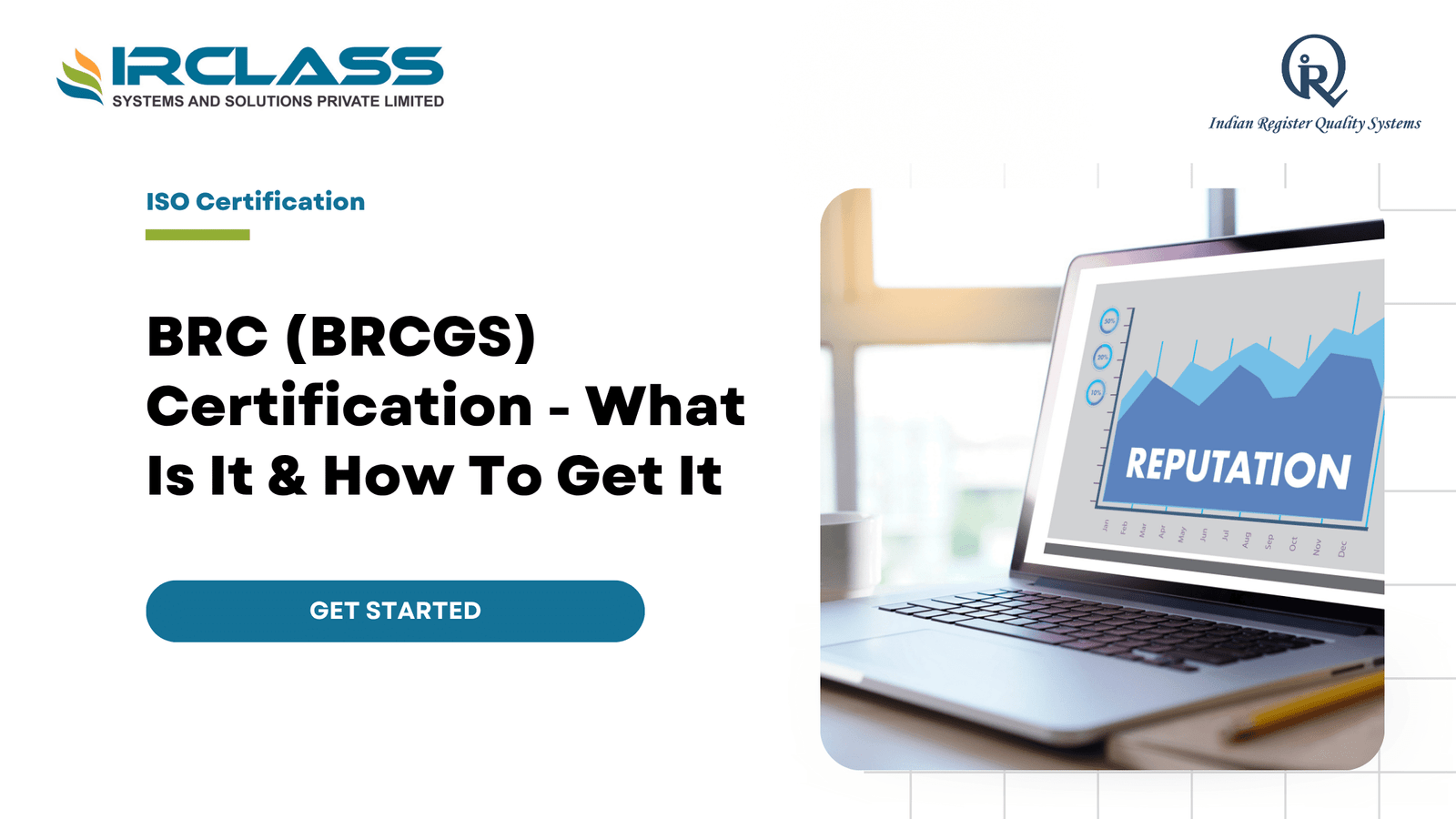
How BRCGS Certification Can Boost Your Brand’s Global Reputation
Brands want to grow. They want to expand into global markets. But they also need to stay safe, consistent, and trusted. One mistake in the supply chain can damage years of credibility. That’s why companies are going for BRCGS certification. It helps them prove they follow global safety and quality standards. It builds trust. It shows commitment. And most importantly, it gives them a clear edge over competitors. BRCGS stands for Brand Reputation through Compliance Global Standards. It sets benchmarks in food safety, packaging, distribution, and consumer product handling. The goal is simple — reduce risk, improve control, and build a brand that customers and partners can rely on. Brands want trust When a brand is BRCGS certified, it means their processes are verified by global auditors. This tells buyers and customers that the company is serious about safety, legality, and quality. It reduces doubts. It reduces questions. It builds confidence right away. Retailers want to work with suppliers they can trust. Distributors want fewer issues. Consumers want safe, reliable products. BRCGS helps deliver all three. Global buyers prefer certified suppliers Most global retailers already have BRCGS in their supplier checklist. If you don’t have it, you may not even get considered. With BRCGS, your brand gets access to new markets. You’re seen as reliable. You’re seen as ready. Without certification, the brand has to work harder to prove its processes. With certification, the brand already meets expectations. This makes a difference in sales meetings, supply chain partnerships, and global distribution deals. Certification builds a competitive advantage Companies with BRCGS certification move faster. They close deals faster. They get approvals faster. That’s because the standard already confirms what others have to explain — their operations meet international norms. In competitive markets, this can be the difference between winning a contract or losing one. It also helps in tenders, audits, and partnerships. Certification makes your brand easier to trust. And being easy to trust is a serious advantage. Certification reduces risk A big risk for global brands is product recalls. Recalls are expensive. They damage the brand. They lose customers. BRCGS reduces this risk. The standard forces companies to track and monitor every step — raw materials, suppliers, production, packaging, and storage. It introduces checks. It finds gaps early. It catches problems before they reach the market. That’s not just about compliance. That’s about brand protection. It brings consistency to the supply chain BRCGS certification doesn’t just improve what happens inside your factory. It strengthens the full supply chain. It forces consistency — in sourcing, in quality checks, and in how information is recorded. This lowers the chances of breakdowns. It builds resilience. It also makes the company easier to scale. You don’t need to rely on a few key people. The system is in place. Companies save time and cost Compliance takes effort. But unstructured compliance takes more. BRCGS requires companies to write things down, run internal audits, follow documented procedures, and train people properly. This builds systems that work. Over time, the company sees better workflow, fewer mistakes, and less rework. This saves cost. It saves time. It also reduces firefighting. Instead of reacting to problems, companies prevent them. It aligns leadership with quality BRCGS doesn’t just focus on technical staff. It requires top management to be involved. Leadership has to take responsibility for food safety and quality systems. This drives cultural change. When leadership owns the system, the rest of the company follows. You get better audits. You get better responses. And you get a company that’s aligned across teams. It shows proof of best practices Many companies say they follow best practices. But only some have proof. BRCGS certification is that proof. It covers: These aren’t optional. They’re part of the audit. And once passed, the brand has a verified certificate to show for it. This builds long-term credibility in the market. It improves transparency More brands are being asked to show where their products come from. How they are made. What checks are done. BRCGS helps answer these questions with facts and documentation. Companies that are certified can show traceability. They can explain processes. They can prove safety measures. This makes them more transparent — and harder to question. Transparency builds trust. And trust builds growth. It helps in ESG and sustainability reporting BRCGS certification is also a means of companies that focus on ESG. The standard offers traceability, waste management, energy monitoring and food safety culture. This enables companies to reach their ESG goals. It also backs up sustainability claims with real audit records. This simplifies investor reports, stakeholder updates and customer communications and makes them more credible. It prepares the company for crisis situations Every brand faces risks. But certified brands are better prepared. BRCGS requires risk assessments, documented recovery plans, crisis response protocols, and regular testing. This gives brands tools to respond fast, stay compliant, and protect their name if something goes wrong. In a global market, this matters. Mistakes go public fast. BRCGS helps you act faster and contain damage. How IRQS Plays an Important Role IRQS works with companies across India and other markets to achieve BRCGS certification. They help brands prepare, correct gaps, train teams, and pass audits. Some of the common projects delivered by IRQS include: Some of the industries that have been assisted by IRQS include: Having 5000+ clients all over the world, 42 offices, and decades of audit experience, IRQS assists companies in realizing the advantages of BRCGS certification in a fast and accurate manner. In conclusion Global markets demand consistency. They demand proof. And they reward companies that meet expectations without needing extra explanation. BRCGS certification gives brands that advantage. It proves that you take quality seriously. It opens doors to new customers, global retailers, and low-risk partnerships. It reduces downtime, improves safety, and gives the brand a better way to scale. IRQS helps companies achieve this. Through real projects, certified auditors, and proven systems, they help brands go from risk to readiness — and
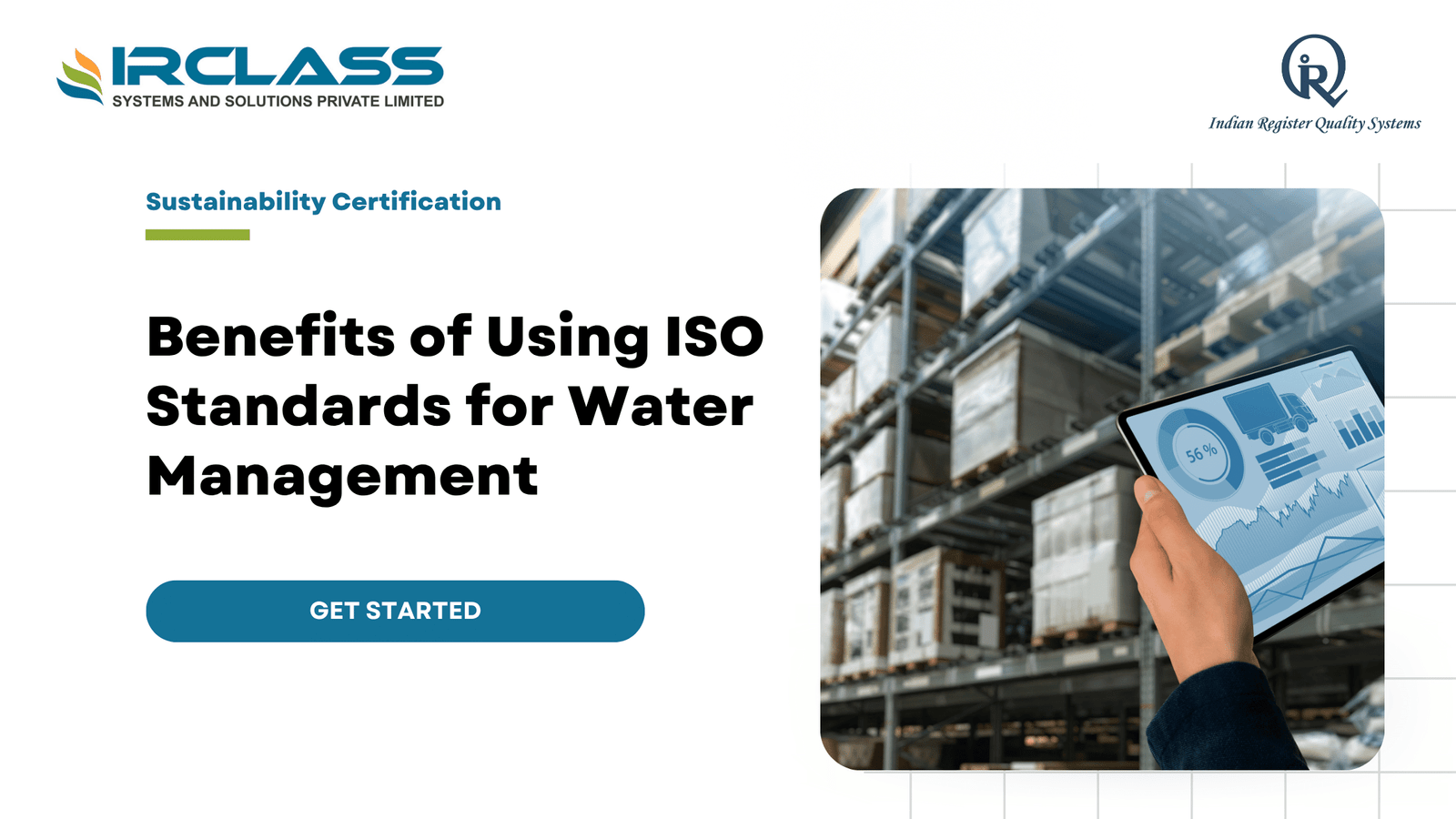
ISO Standards Supporting Water Neutrality: What You Need to Know
Water scarcity is now a business problem. It’s no longer limited to climate reports or policy discussions. Companies across sectors are under pressure to cut down water usage, recycle more, and prove they are not draining shared resources. This is what water neutrality means: balancing what you take with what you give back or reuse. But achieving it is hard. Most companies don’t even know how much water they use. Or where the losses are. Or what a realistic target looks like. This is where ISO standards come in. There is no single ISO standard labeled “Water Neutrality.” Instead, a group of related standards supports it. Together, they provide what most companies lack: a system. With structure. With metrics. With accountability. This document explains how each standard contributes, what actions they demand, and what outcomes they deliver. ISO 46001: Water Efficiency Management System This is the main ISO standard for managing water use. It is built like ISO 9001 or 14001. It gives a system to control water use in any type of organization. Key points: Why it matters: Companies usually look at their water bill and guess. ISO 46001 stops that. It builds a repeatable way to manage water, with data. The benefit is real: lower bills, fewer leaks, better planning. ISO 14046: Water Footprint This criterion is on impact. It is regarding the greater good, i.e. the environmental cost of water used in a product or process. It waters using life cycle assessment (LCA). Key points: Why it is important: ISO 46001 tells you how much water you are taking. ISO 14046 will tell you what kind of damage that water consumption is causing. It is not volume, but location, timing and scarcity. This is necessary to companies that produce products in bulk. ISO 24510, 24511, 24512: Water and Wastewater Services These are to utility and service companies anyone who provides water or who deals with wastewater. It is all about quality, reliability, and sustainability of services. Key points: Why it is important: This is the spine of governments and utilities. Yet even privately operated water systems, which operate internally, such as in industrial parks, can utilize this to reduce expenses and achieve regulatory objectives. ISO 14001: Environmental Management Systems ISO 14001 is not just about water. It encompasses all environmental effects. However, it gives the umbrella under which ISO 46001 and 14046 can work. Key points: Why it is important: The majority of companies are already ISO 14001 compliant. Therefore, the incorporation of water-related standards into the current systems is time-saving and non-duplicative. Supporting ISO Standards Other ISO standards support water neutrality in indirect but important ways: These don’t drive water neutrality alone, but they enable safety, continuity, and cross-efficiency. Business Benefits Reduced Operating Costs Water is costly and it is increasing in price. ISO 46001 assists in cutting down on wasteful consumption. ISO 14046 assists in redesigning and sourcing. Regulatory Readiness Most nations are introducing water regulations. ISO systems maintain records and show compliance. Improved ESG Reporting ESG audits include water use and discharge. The ISO standards assist companies to report in a reliable way, in a language that is understood by investors. Improved Reputation Customers are observing. Suppliers are so too. The fact that ISO water certifications are being made is evidence that something is being done. Sustainable Growth Scarcity of water may restrict growth. ISO systems assist companies in making better use of water and making it more sustainable, which opens up future capacity. Implementation Challenges Initial Cost Setting up these systems takes time and resources. But the ROI is strong: usually under three years. Data Gaps Many companies don’t have water data systems. Meters are missing or uncalibrated. Fixing that is step one. Cultural Shift Changing water habits inside a company is slow. ISO helps by forcing consistency. It turns change into policy. Auditing Pressure Once certified, companies must maintain it. This means ongoing documentation, review, and re-training. How to Begin Real-World Example: Multi-Site Manufacturer A large Indian textile company had high water bills and low recycling. They used ISO 46001 to track water use at 6 plants. Leaks and losses were found. Rainwater systems were added. Water usage dropped 28% in 18 months. They added ISO 14046 to measure product-level impact. Customers now ask about water data, and the company is ready to answer. Conclusion: Why IRQS Matters Water neutrality is becoming a must-have for businesses. The standards are available. The benefits are proven. But implementation is not easy. You need a partner who understands the technical standards and the business realities. IRQS fits this role. They have certified over 5000 clients. They offer ISO 46001, 14046, 14001, 24510, and more. They don’t just certify. They train. They consult. They help companies move from intention to action. IRQS has worked with manufacturers, utilities, food companies, IT parks, and more. They bring real-world experience. Their trainers and auditors understand what works and what doesn’t. For any business serious about water neutrality, IRQS is the right place to start. They help you avoid delays. They help you meet standards. They help you get results.
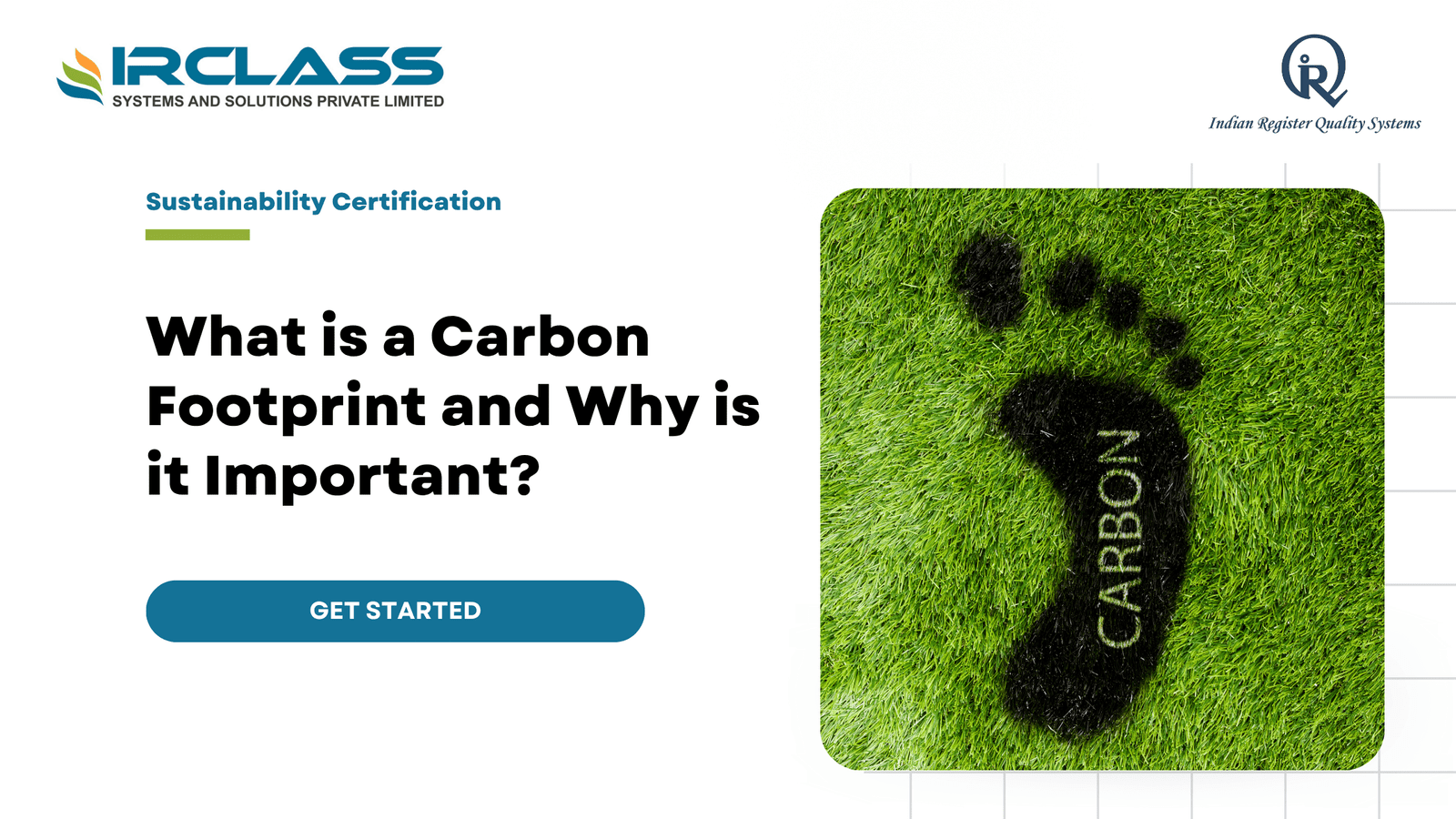
What Is Carbon Footprint Verification & Why It’s Critical for Your ESG Goals
Carbon footprint is not just a number. It’s a signal. It tells the world how your business interacts with the environment. And as ESG becomes a core part of how investors, customers, and regulators judge companies, that signal needs to be clear and credible. Carbon footprint verification is the process of checking that your emissions data is accurate, complete, and reliable. It’s how you show that your reporting is real, not just good intentions. Without it, your ESG strategy is just a story. With it, you’ve got proof. Why Carbon Footprint Matters in ESG ESG stands for Environmental, Social, and Governance. The “E” is often the hardest to measure—but also the most urgent. From climate regulations to investor pressure, environmental performance is under the spotlight. Carbon emissions are at the center of that conversation. If you can’t measure your carbon footprint, you can’t reduce it. And if you can’t prove what you’ve measured, no one will take it seriously. That’s where verification comes in. It’s Not Just About Saving the Planet—It’s About Staying in Business Governments are introducing stricter climate rules. Investors are screening for climate risk. Big corporations are auditing their supply chains for emissions. If you can’t show your numbers—or worse, if they’re wrong—you lose out. Carbon footprint verification helps you stay compliant, avoid greenwashing claims, and build trust. It’s not just good for the planet. It’s smart business. What Verification Actually Does Verification is not an internal review. It’s not based on assumptions. It’s a third-party check. Auditors look at your data, your process, and your calculations. They test it against international standards like ISO 14064 or the GHG Protocol. They don’t just ask “did you do it?” They ask “did you do it right?” Once verified, your carbon data becomes credible. You can use it in ESG reports, investor updates, sustainability claims, and supplier assessments. Why Verification Adds Real Value Anyone can publish an ESG report. But not all reports are created equal. Verified carbon data gives you a competitive edge. It shows stakeholders that you take sustainability seriously—and that your numbers are backed by real checks. It also helps you spot problems. During verification, issues often surface that might have been missed: incorrect assumptions, missing data, and wrong conversion factors. Fixing them early means better decisions and lower risk. Carbon Footprint Verification Supports Better Strategy When you know your real impact, you can make real plans. Verified data helps you set science-based targets. It lets you track progress over time. It helps you compare sites, teams, and suppliers. And it helps you talk about climate action with confidence. This is about more than optics. It’s about building a strategy that’s grounded in truth, not guesswork. Companies Are Being Held Accountable Carbon claims are under pressure. Consumers are asking for proof. Regulators are cracking down on false sustainability messages. Investors are running climate stress tests. If your carbon data isn’t verified, you’re exposed. There’s a growing expectation: show your math. If you say you’ve cut emissions by 20%, stakeholders want to know how you calculated it. Verified data removes doubt. What Gets Verified? A proper carbon footprint verification looks at: Every step is checked. If something doesn’t add up, it gets flagged. That’s how you move from estimates to accuracy. Carbon Verification Builds Market Confidence Today, ESG scores affect your brand, your funding, and your partnerships. A strong carbon verification can lift your ESG rating. It can make ESG data providers take you seriously. It can give banks and investors more comfort when evaluating risk. It’s also becoming part of procurement. Large buyers are now requiring emissions data from their suppliers. Verified numbers get you in the door faster. It’s Cheaper to Get It Right the First Time Unverified data might seem faster. But mistakes are expensive. Fixing a flawed report, responding to scrutiny, or correcting the record later costs time and trust. Verification saves you from that. Think of it like an audit for your emissions. It gives you confidence that what you’re reporting is real. And it lets others trust you without second-guessing. Verification Is a Step Toward Net Zero Many companies have set net-zero targets. That’s great. But targets without credible measurement are just promises. You can’t manage what you can’t measure—and you can’t prove what you haven’t verified. Carbon footprint verification isn’t just a checkbox. It’s the foundation. Once your emissions data is solid, you can build real reduction plans, track real outcomes, and show real progress. The Push Is Coming from All Sides The pressure to verify is growing: This isn’t a future problem. It’s happening now. Businesses that move first get ahead. The rest get left behind. Don’t Wait for Regulation It’s easier to start when the choice is yours. Waiting for mandatory rules means rushing under pressure. It means higher costs, more mistakes, and more stress. Voluntary carbon footprint verification puts you in control. You set the pace. You choose the scope. And you’re ready when regulation comes. You Don’t Need to Have Everything Perfect You can start small. Pick one site, one product line, or one business unit. Verify that. Build your approach over time. What matters is that you start. Verification is not about being flawless. It’s about being transparent, consistent, and committed. Conclusion Carbon footprint verification is no longer just a best practice. It’s a business need. It strengthens your ESG reports, protects your brand, and positions you for the future. The companies that take this seriously today will be the ones leading tomorrow. If you’re ready to verify your carbon footprint, work with a partner who knows how to do it right. IRQS brings experience, credibility, and a clear process. They help you move from estimates to evidence, so you can build trust where it counts.
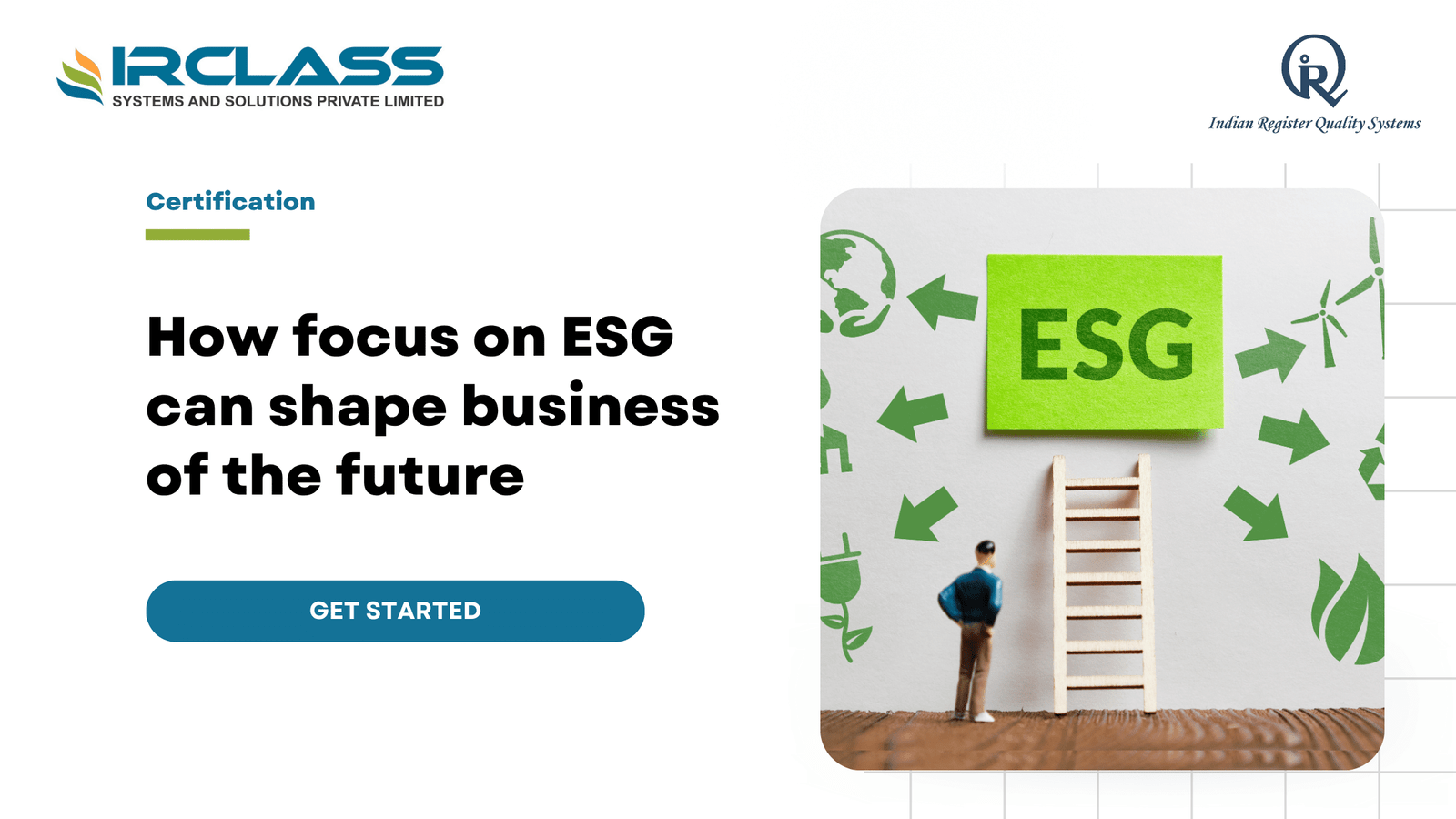
Why ESG Reporting Is the Future of Business Strategy
Businesses are evolving. Investors are looking beyond profit and loss statements. Customers are asking what companies stand for. Employees want to work for organizations that care about more than just the bottom line. That’s where ESG reporting comes in. ESG stands for Environmental, Social, and Governance. It’s not just a trend. It’s becoming a core part of how businesses operate, make decisions, and plan for the future. If you’re not thinking about ESG reporting today, you’ll be playing catch-up tomorrow. ESG Is Not Optional Anymore Regulations are tightening. Governments around the world are rolling out mandatory ESG disclosures. Investors are demanding transparency. And large corporations are asking their vendors and partners to show ESG performance. This means even smaller companies need to be ready. What used to be voluntary is becoming essential. Businesses that can’t show how they’re managing environmental impact, treating employees, and governing responsibly are at risk of losing deals, funding, and reputation. It’s Not Just About Risk—It’s About Opportunity ESG isn’t just a shield. It’s a lever. Companies that lead in ESG are attracting better talent. They’re winning the trust of consumers. They’re unlocking new sources of capital. Investors are now using ESG scores to decide where to place their money. Customers are willing to pay more for products from companies that align with their values. And top employees want to work where they see purpose, not just paychecks. So, ESG reporting doesn’t just help you avoid fines or bad press. It helps you grow. Why ESG Reporting Builds Better Businesses When companies track ESG data, they start asking better questions. How much energy are we using? Are our suppliers treating their workers fairly? Do we have diverse leadership? Are we transparent about decision-making? These aren’t just compliance issues. They’re business strategy issues. Companies that answer these questions can spot inefficiencies. They can build stronger supply chains. They can respond faster to crises. That makes them more resilient. Good ESG reporting also brings discipline. It creates clear goals and accountability. It forces leaders to measure what matters—not just what’s easy. What ESG Reporting Includes A strong ESG report covers three pillars. Each one tells part of the story: Each area connects back to long-term value. That’s why ESG reporting is now part of investor meetings, RFP responses, and boardroom discussions. ESG Reporting Is a Signal of Long-Term Thinking Short-term results are easy to chase. But they’re fragile. One scandal, one lawsuit, or one environmental mishap can destroy years of work. ESG helps companies focus on the long game. It shows that leaders are thinking beyond this quarter. They’re managing risk, building trust, and investing in the future. And markets are noticing. The companies that survive downturns and win in the long run are the ones with strong ESG foundations. The Pressure Is Rising More than 90% of the S&P 500 now publish ESG reports. Banks are factoring ESG risk into lending decisions. Governments are linking ESG performance to procurement contracts. That’s not a coincidence. It’s a shift. If your business isn’t preparing for ESG reporting, you could lose out. Deals will slow down. Capital will become more expensive. Customers will go elsewhere. And eventually, regulators will come knocking. Doing nothing isn’t safe anymore. Technology Is Making ESG Easier The good news? ESG reporting doesn’t have to be manual or messy. Tools are improving. Data is easier to collect and track. Standards are becoming clearer. What used to take months can now be done in weeks. And if you start early, the workload stays manageable. You can embed ESG into your existing systems, rather than treating it as a bolt-on. That saves time, money, and headaches later. You Don’t Need to Be Perfect—You Just Need to Start One of the biggest myths is that you need perfect ESG scores from day one. That’s not true. What matters is progress and honesty. Stakeholders want to see that you’re aware, committed, and improving. Transparency builds trust. Even if you’re still working on your goals, sharing the journey makes a difference. ESG reporting isn’t about saying “we’ve arrived.” It’s about showing you’re on the right path. Small Companies Can Lead, Too ESG isn’t just for the big players. In fact, smaller companies have an advantage. They can move faster. They can build ESG into their culture from day one. They can align teams quickly and show early wins. And when they do, they become more attractive partners. Large enterprises now ask ESG questions during vendor onboarding. If you’re already prepared, you move to the front of the line. 5 Reasons ESG Reporting Matters Right Now That’s not a trend. That’s a shift in how the world does business. Looking Ahead: ESG as a Competitive Advantage As markets evolve, ESG will separate leaders from laggards. It will define who gets funded, who wins contracts, and who stays in the game. Companies that treat ESG reporting as a checklist will fall behind. The ones that see it as strategy will lead. The sooner you act, the more control you have. You can shape the narrative, build credibility, and stay ahead of change. Waiting only makes things harder and more expensive. Start Before You’re Forced To By the time regulators come knocking, it’s too late to start. You’ll be reacting, not leading. ESG reporting is easier when it’s proactive. When it’s part of your planning—not an afterthought. That’s the mindset companies need now. ESG isn’t just a report. It’s a reflection of how your business sees the world—and its role in it. Conclusion ESG reporting is here to stay. It’s not just about compliance. It’s about building a business that’s trusted, resilient, and ready for the future. Whether you’re a startup or an established brand, now is the time to act. If you want to start your ESG journey the right way, work with someone who understands the full picture. IRQS has helped companies across industries build strong ESG frameworks that stand up to scrutiny. Their team knows what it takes to go
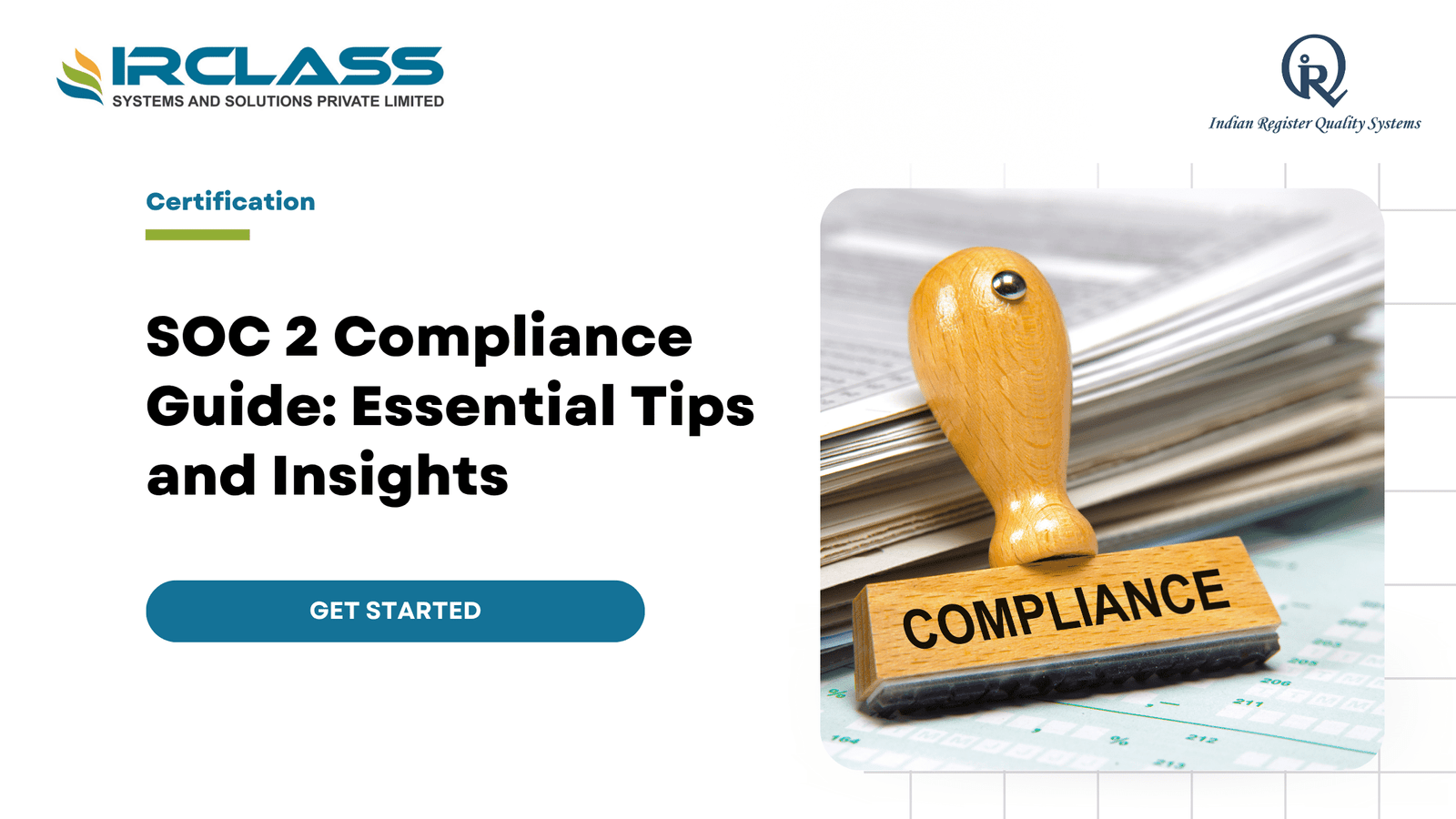
SOC 2 Compliance Explained: 7 Secrets Every Tech Leader Must Know!
SOC 2 compliance is not just a checkbox. It’s a trust signal. If you’re running a tech company or scaling a startup, you’ve probably heard about it in investor meetings, customer onboarding, or boardroom talks. But the truth is, most leaders still don’t fully understand what SOC 2 really means—or what it takes to get there. It’s not just about avoiding fines or meeting some legal requirement. It’s about showing the world that your company takes data security seriously. And in 2025, that matters more than ever. Whether you’re building SaaS, handling customer data, or offering any digital service, your customers want to know their data is safe. SOC 2 gives them that assurance. But going after it without a plan can cost you months and thousands of dollars. That’s why these 7 secrets matter. SOC 2 Isn’t a One-Time Job SOC 2 is not a one-and-done report. It’s a continuous process. Once you get certified, you need to stay compliant every day, not just once a year. Think of it as a lifestyle for your company’s data. Many companies get caught off guard during the renewal phase because they didn’t build long-term habits. Tools and policies help, but it’s your culture that keeps you compliant. That culture needs to start at the leadership level. You Don’t Need to Be Big to Get SOC 2 Some startups wait too long to start thinking about SOC 2. They think it’s something only enterprises need. That’s not true anymore. Even early-stage companies are being asked for SOC 2 reports by customers, especially in B2B deals. If you’re storing customer information, you’re a candidate. Being small doesn’t excuse you. In fact, getting certified early can help you close bigger clients faster. SOC 2 Type I vs Type II—Know the Difference This is where many people get confused. SOC 2 Type I checks if you have the right systems in place at a single point in time. It’s like taking a picture. Type II checks if those systems actually work over time—usually over a 3 to 12-month period. That’s more like a video. Most companies start with Type I because it’s quicker. But serious customers ask for Type II. You’ll need both, eventually. Plan for it early. Automation Won’t Save You Without Process Yes, there are plenty of tools that claim to automate SOC 2 compliance. But without clear internal processes, those tools won’t help. Compliance still needs humans to define policies, assign access, and review incidents. A lot of companies invest in tech stacks before they invest in basic security policies. That’s backwards. Define your policies first. Then pick the right tools to support them. Trust Services Criteria Are Not Just Checklists SOC 2 is based on five trust principles—security, availability, processing integrity, confidentiality, and privacy. But they’re not just checklists. They’re a framework for how your company handles data at every level. Each of these principles touches multiple teams—IT, engineering, HR, legal, and product. SOC 2 forces cross-functional discipline. You can’t leave it all to the CTO. SOC 2 Reports Are Meant for Clients, Not Just Auditors Your auditor isn’t the only person who will see your SOC 2 report. Clients, partners, and even regulators might ask for it. That’s why it needs to tell a story. A good SOC 2 report explains how your systems work in plain English. It doesn’t just throw technical jargon. Executives need to be involved in shaping that story. A technical report without business context won’t build trust. You’ll Never Be 100% Ready—Start Anyway Many companies delay the SOC 2 journey because they think they need everything perfect. That’s a mistake. You can start with what you have and improve as you go. What matters is that you show intent, take real steps, and commit to continuous improvement. The biggest obstacle is fear—fear of gaps, audits, and unknowns. But those fears shrink when you take the first step. Get a readiness assessment. Document your controls. Train your team. Action beats analysis every time. 5 Things You Can Do Right Now Your Reputation Is Built on Trust SOC 2 is more than a technical standard. It’s a business enabler. It can shorten sales cycles, strengthen partnerships, and attract enterprise clients. But more than that, it protects your brand. And once trust is broken, it’s hard to win it back. Founders and tech leaders who take SOC 2 seriously stand out. They show maturity. They show that they’re ready for growth. In today’s market, that’s everything. Getting SOC 2 right early saves time later. No last-minute scrambles. No lost deals because a security review went sideways. It shows investors and customers that you’re thinking ahead. That you’re building something solid, the companies that win are the ones that prepare before they’re forced to. You don’t need a big security team to get started. You need a clear plan and the right support. That’s where firms like IRQS come in. They’ve done this before—and they know what matters when everything’s on the line. Work with a Partner Who Knows the Space SOC 2 compliance can feel like a maze. That’s why it helps to work with people who’ve done it before. Indian Register Quality Systems (IRQS) has guided companies across industries through complex compliance frameworks. Their team understands what tech leaders need—not just to pass an audit, but to build lasting trust. If you’re starting your SOC 2 journey, this is where to begin. IRQS doesn’t just offer checklists—they help you understand what matters and why. From identifying gaps to preparing for the audit, they bring clarity at every step. You’ll know what your auditors expect and how to meet those standards without wasting time. They’ve worked with startups, large enterprises, and everything in between. That means they’ve seen what works—and what doesn’t. If you’re building a product that handles customer data, this isn’t optional. Get it right the first time. Work with people who already know the path.
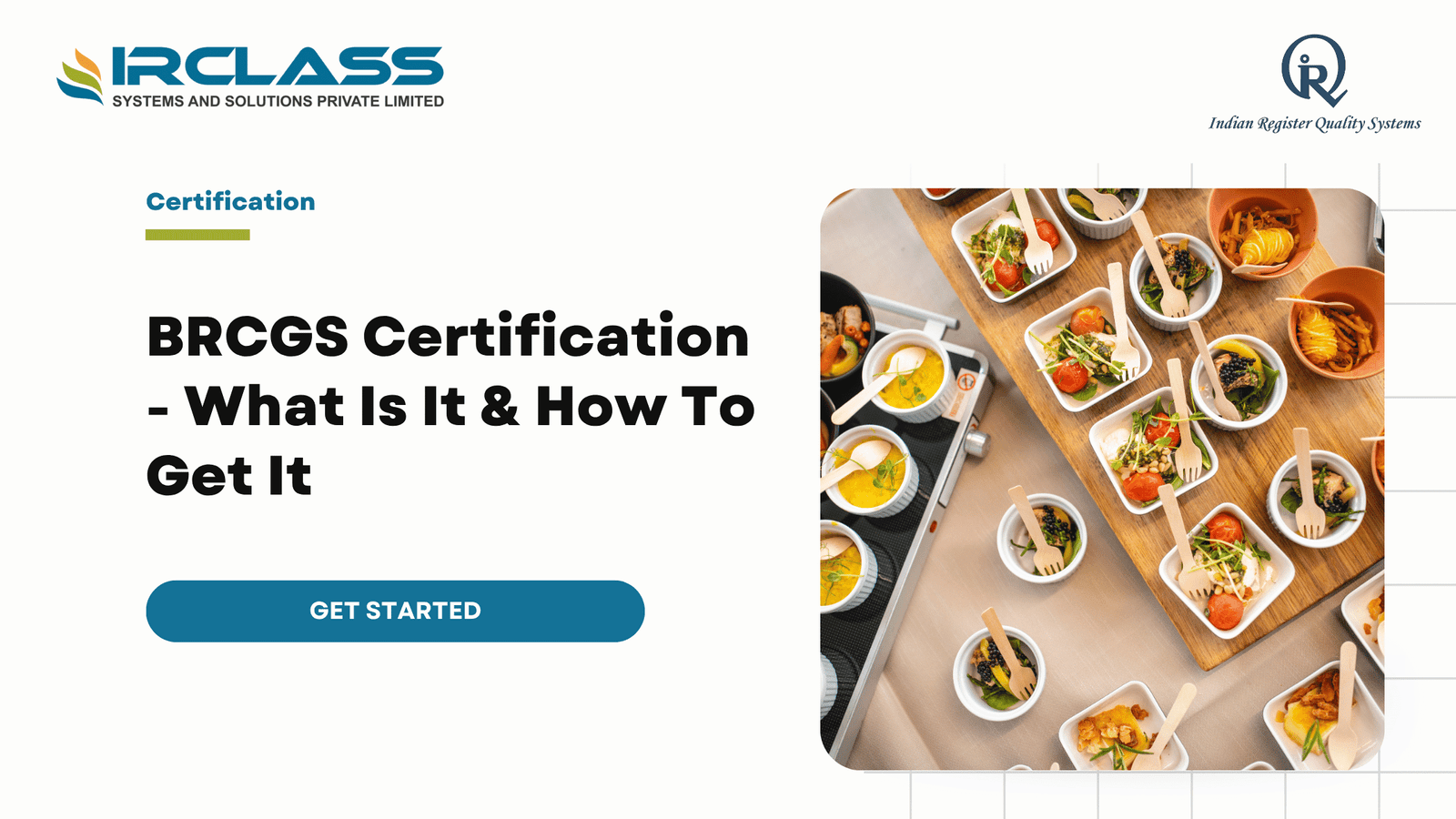
Step-by-Step Guide to BRCGS Certification for Food Businesses
Now that food safety is important both to the law and to customers, businesses in food production must demonstrate their care for quality and hygiene. If you are in the food industry as a manufacturer, processor, packer or distributor, getting a globally accepted certification can increase your reputation and help you access new markets. The BRCGS (Brand Reputation through Compliance Global Standards) certification is a highly respected food safety standard around the globe. Many retailers, manufacturers and food service companies around the world rely on BRCGS certification to manage food safety, quality and comply with laws. What is required to achieve BRCGS certification? This guide explains all the necessary steps, starting with learning about the standard and ending with keeping your business compliant over time. What Is BRCGS Certification? BRCGS is short for Brand Reputation Compliance Global Standards. Originally developed by BRC, it is now a respected brand that establishes strict rules for food safety, packaging, storage, and consumer items around the world. Food manufacturers and processors use the BRCGS Food Safety Standard, which is approved by the GFSI and recognized globally. With certification, food businesses can handle safety, integrity, legality, and quality using an official framework. Besides the badge, it gives retailers, suppliers, and consumers the confidence that your products are the best in the industry. What You Need to Know Getting BRCGS certification gives a business an advantage in the international food market. Retailers and supermarkets may require you to have it. With certification, your internal operations are improved, your team becomes more aware, products are easier to track, and the risk of recalls or legal problems is lowered. Because a single food safety scandal can destroy a brand, having an effective and approved food safety system is now vital. The first step is to learn about the BRCGS Food Safety Standard First, download the latest edition of the BRCGS Global Standard for Food Safety. Read through it carefully to understand what your business will be judged on. The standard is based on various parts, including top management support, HACCP, food safety and quality systems, and good manufacturing practices (GMPs). It is necessary for leadership and quality teams to align with everything the standard sets out—from how documents are handled to how production is managed. Step 2: Perform a Gap Analysis After that, you should conduct a detailed gap analysis. Comparing your current system to the BRCGS requirements is part of this process. A gap analysis points out any issues, non-conformities, or missing processes that may affect your chances of being certified. For every gap, document it and establish a clear plan to fix it. This allows you to start making improvements in your system. Step 3: Develop or Improve Your Processes for Food Safety As soon as areas for improvement are found, update or create your Food Safety Management System (FSMS) to fulfill BRCGS requirements. These policies, procedures, records, and manuals should be based on the standard. Key elements usually include: Your FSMS needs to be carefully organized, recorded, and implemented in daily operations—not just written down. Step 4: Inform and Train Your Workforce Your certification relies on the success of the people you work with. All staff members involved in production, quality assurance, warehousing, and management should be trained on the BRCGS standard and your FSMS. Topics covered in training might include food hygiene, personal hygiene, cross-contamination, cleaning procedures, and the company’s reporting system. It is important to set up training regularly to cover new risks, updates to processes, or changes in the standard. Step 5: Carry Out Internal Audits Conduct internal audits in all departments before the official audit takes place. This gives you a chance to identify areas for improvement and simulate the real audit experience. Review your documentation, observe operations, interview employees, and document findings. Any non-conformities should be investigated and corrected with proper action plans. Step 6: Pick a Certification Body Now it’s time to select a certification body that is BRCGS-accredited. You need to find one with expertise in your sector and the ability to interpret the standard as it applies to your company. Collaborate with your chosen body to set the audit date, assess your readiness, and determine required documentation. Step 7: Plan and Set Up the Certification Audit Most often, your first audit is an announced audit. All parts of your food safety system will be assessed during the audit, including: All clauses in the BRCGS standard will be reviewed by the auditor. The results determine your grade—AA, A, B, or C. A higher grade increases credibility and can influence how often audits are required. Step 8: Address Any Non-Conformities Should non-conformities be found during the audit, don’t panic. You’ll have the opportunity to respond. Submit corrective action plans and supporting evidence within the defined period (usually 28 days). Once your application is approved, your certification will be granted. Step 9: Share Your Certification After receiving your BRCGS certificate, it’s important to share the news. Include the certification in your marketing materials, inform your clients, and update your website. For many retailers and distributors, this certification is a prerequisite to doing business. Step 10: Maintain and Improve Achieving BRCGS certification means committing to continuous improvement. To ensure ongoing compliance: By consistently improving, your business remains compliant, resilient, and ready for growth. Step 11: Recertify Your System Your BRCGS certification is typically valid for 12 months. A recertification audit is required before it expires. This process verifies that your organization maintains consistency and demonstrates ongoing improvement. Depending on your previous performance and risk level, recertification audits may be unannounced. You should always keep your food safety systems audit-ready. Usual Problems and How to Solve Them Some businesses face challenges like staff turnover, missing documentation, or lack of leadership involvement. These can jeopardize your certification efforts. The key to overcoming them lies in: Avoid shortcuts—they may lead to failed audits, financial losses, and damaged reputations. In Conclusion Gaining BRCGS certification is not only about following rules—it’s about enhancing your business.
Search
Useful Links
Recent Posts
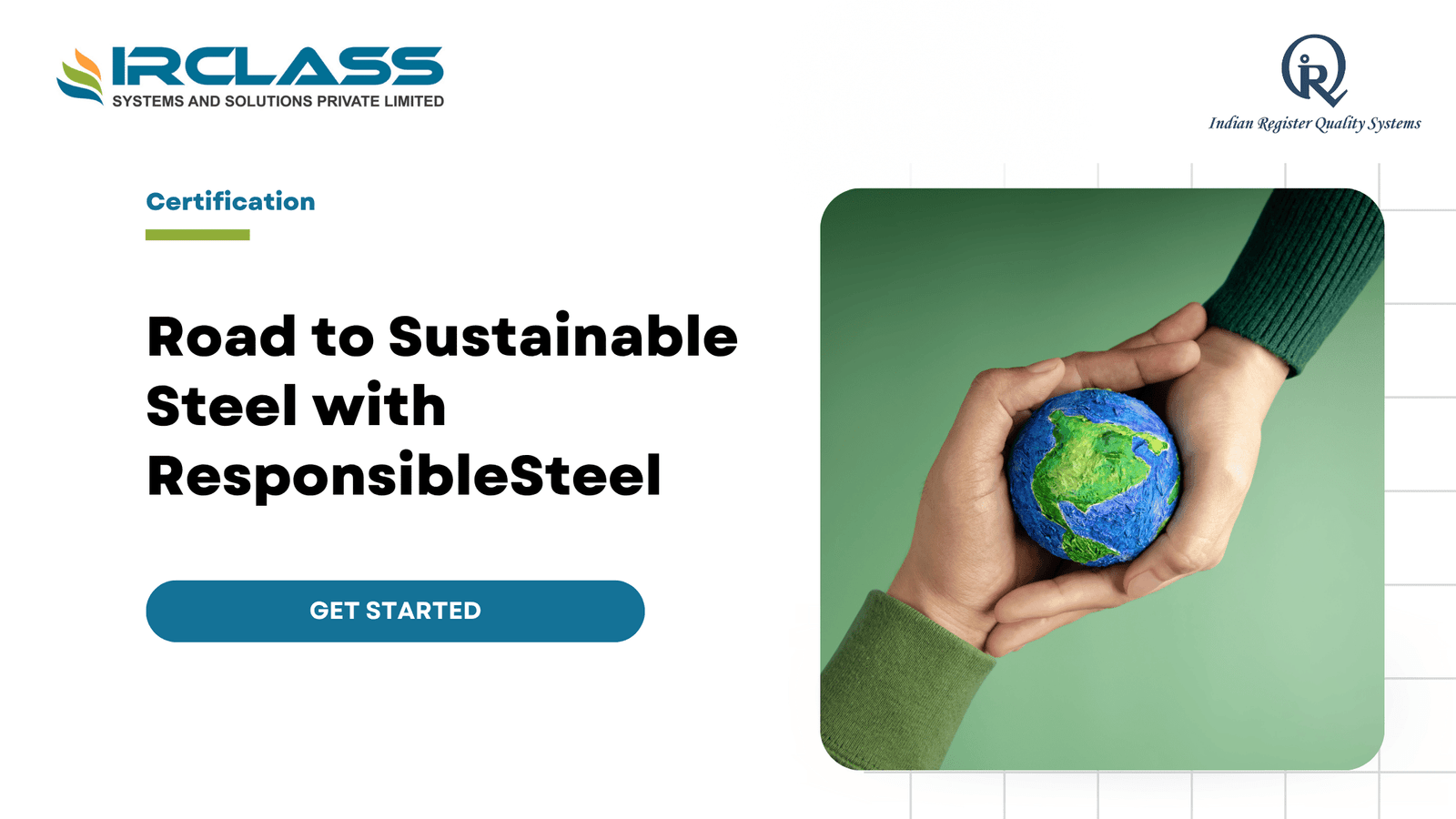
What is ResponsibleSteel? A Comprehensive Guide to Sustainable Steel Certification
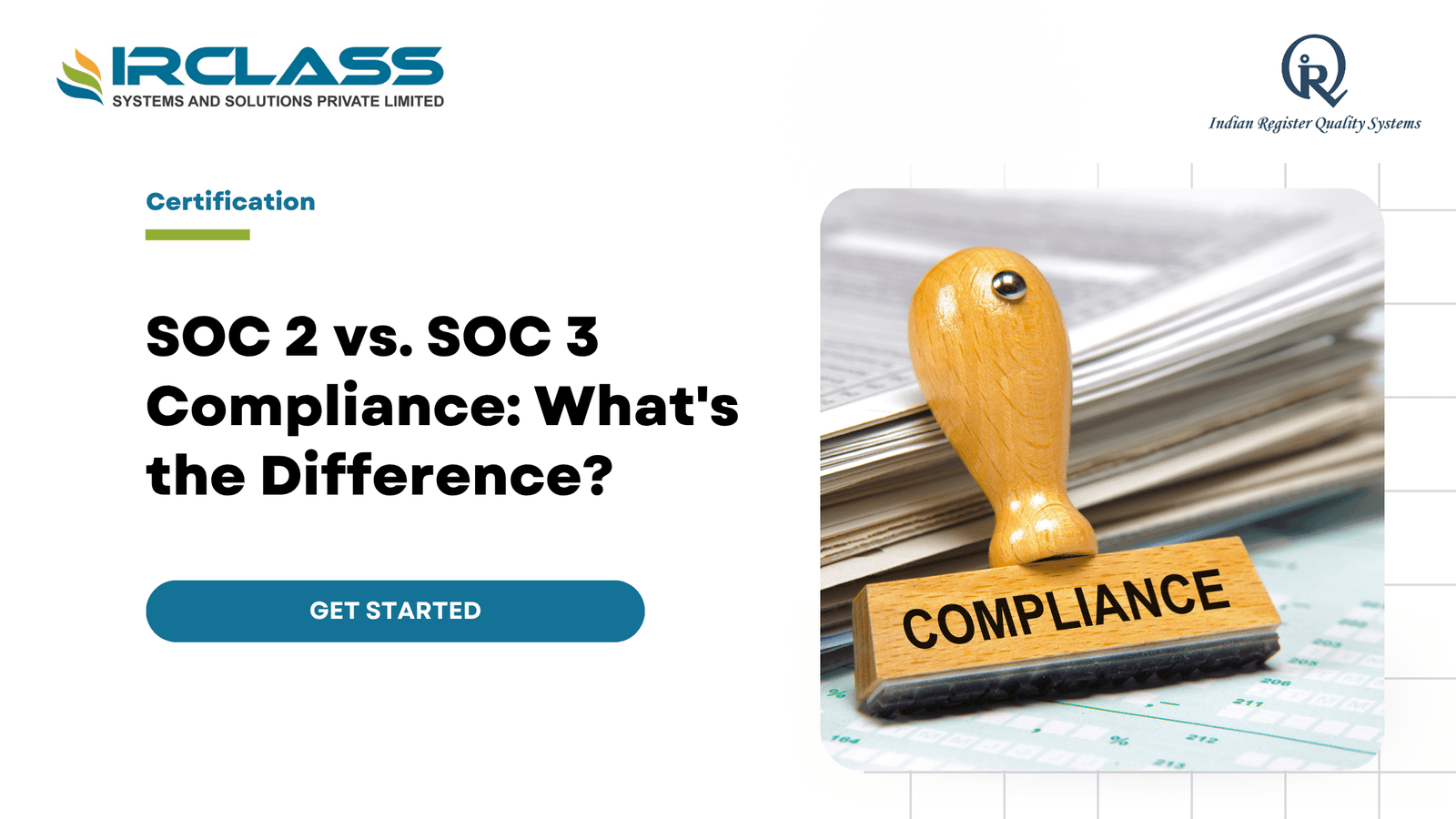
SOC 3 vs. SOC 2: Which Compliance Report Suits Your Business Needs
